



May–June 2024





May–June 2024
On a recent trip to Liverpool, we looked around the two cathedrals in the city – one Catholic, one Anglican. Both are equally impressive in their architecture, with the buildings looking at each other down the length of Hope Street. The red-brick Anglican cathedral is the largest in the UK and is built in the traditional cross shape, while the Metropolitan Cathedral of Christ the King Liverpool is the largest Catholic cathedral in England and built in a circular shape with the altar in the middle. Clearly both require very different audio solutions. The Anglican cathedral – with a footprint of over 10,000m2 –has a reverberation time of over 8s and needed a setup that would provide clear, intelligible audio reproduction

architectural issues. Today, it boasts the largest Yamaha DME system in Europe. When the Metropolitan Cathedral opened its doors in 1968, it suffered from highly reverberant acoustics. Now, electronically steerable line array column speakers cover the wide seating areas, enclosed in custom-built units to create a feature out of the speakers that would otherwise be impossible to hide. Hats off to all systems integrators that have the ability to take any house of worship of any size or shape and expertly provide an audio solution that makes these spaces sound as amazing as they look.
I hope you enjoy the issue.


Nick Smith Digital media manager nsmith@worshipavl.com
Email: kwallace@worshipavl.com PUBLISHED BY:
Spa House, 18



Carolyn Valliere Sales associate cvalliere@worshipavl.com
Chris Yardley Video editor cyardley@worshipavl.com






All rights reserved. No part of this magazine may be reproduced or transmitted in any form or by any means, electronic or mechanical, including photocopying, recording or by any information storage and retrieval system, without prior permission in writing from the copyright owners. Follow us on social media
Simon Luckhurst Senior reporter sluckhurst@worshipavl.com
Marne Mittelmann Circulation manager circulation@worshipavl.com
LICENCES: Singapore: MICA (P) 014/05/2023 PPS 1644/05/2013(022954)
CIRCULATION: circulation@worshipavl.com
Robert Soo considers the importance of sound techs, musicians and singers understanding the operational needs of the worship team

WELCOME TO THE LATEST instalment of Because everyone matters, a series that touches on audio, video and lighting setups and practices that help church members enjoy a deeper engagement in worship services. The first two articles touched on improving the sound and visual experience for both the onsite and online worshippers. Today, I would like to shift our focus to a specific group of people who commit themselves weekly to the role of a Levite – The Worship Team. I have a special interest in this as I’ve served as a worship leader and a musician for many years, and although I am no longer actively serving, I still spend a considerable amount of time equipping and working with many worship ministries today. A typical worship team consists of at least one worship leader, several singers, an occasional choir and, of course, the musicians, with differing setups depending on the respective church’s worship music culture, stage size, availability of volunteers, etc. However they are set up, musicians and singers require the understanding,
help and support of AV personnel and church leaders in order to perform at their best. They have long-standing needs of which many are still widely misconstrued and mismanaged today, and therefore it is important that we address them as best as we can.
One of the most fundamental needs is proper stage monitoring that allows musicians and singers to hear themselves and each other –without it, you could compromise their performance and subsequently affect the worship service. Stage monitoring systems come in several forms, with the longest-serving being wedge floor monitors and instrument amplifiers. Today, in-ear monitors (IEMs) used in combination with either a wireless system or a personal monitor mixer have steadily gained popularity among church musicians and singers, and FOH sound techs celebrate it for freeing them from monitor duties as well as helping to manage issues like stage noise and acoustic feedback. IEMs actually have another nice benefit that conventional monitors cannot support effectively – they allow for a

and, secondly, stereo panning and reverberation should be applied into the IEM mix to simulate the natural acoustic environment our ears are used to hearing.
Conducting sound checks is essential not only in ensuring every input source in the mix is properly levelled and balanced before the service starts, it also assures the musicians and singers that the sound crew is genuinely invested in helping them


click track as well as the team leader’s verbal instructions to be heard by every musician and singer, without alerting the congregation. This has proven to be extremely useful, especially with today’s more complex church music arrangements.
IEMs were introduced some 30 years ago – with so many positives, why did it take such a long time to gain acceptance among church users? There are many reasons behind this, but one of the most prevalent is that it sounds and feels “unnatural”, especially to first-time users. Anyone advocating the use of IEMs should first appreciate what it actually feels
perform and succeed as a worship team. I’ve often told this story about how I came across this church sound tech who had muted the bass guitar channel for two services without even noticing it, so he may be quite clueless about band and music fundamentals. Sound techs are often encouraged to learn about their musicians’ instruments, their setup as well as to support the weekly rehearsals to prepare for the services. Such acts are simple but impactful, and will instil trust and confidence between the worship team and the sound techs. Churches today are investing in higher-performance audio mixers,


significantly to the final production quality. Many are under the impression that all DIs work and sound the same, so I frequently conduct DI comparisons in my trainings to educate users on the distinct sonic difference between team reach out more effectively with their music is definitely a worthwhile investment because the cost difference is insignificant compared to the vast positive difference they make. A great visual aid for the worship leader and singers (and preacher)

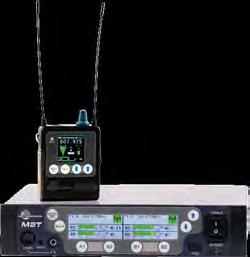

which serves as a point of reference implemented either as a downstage monitor or as a large display located at the rear of the sanctuary, the latter has always been my preferred approach as it allows the singers to maintain eye contact with the worshippers. Downstage monitors have a similar effect to using traditional song sheets, where they draw singers to look down and eventually lose that important Another important consideration is how musicians and singers are positioned onstage (or offstage) that will enable them to perform optimally
convenience or stage aesthetics. Here are a couple of basic but pertinent but pertinent guidelines for a more practical
Musicians and singers should be able to see and communicate effectively with each other, and be able to monitor the worship leader’s cues given during worship.
• Singers, choirs and acoustic instruments (a) should be positioned away from loud sources like drums and stage amplifiers to avoid microphone
bleed, and (b) should never be positioned in front of the FOH loudspeakers to prevent acoustic feedback.
Just as I encourage the sound techs to understand the operational needs of the worship team, musicians and singers are also encouraged to do likewise and take that step towards understanding and appreciating some key technical requirements and concerns of the sound team. For example, why the constant request to lower the volume of stage monitors and stage amplifiers? Why do they need such a long time to conduct a sound check? Why do they need singers to hold their mics closer to their lips and never cup a microphone? Equipping the worship team with such knowledge will go a long way towards mutual understanding and respect between the two camps and ensures smooth running of worship services.
I hope this short article has shed some light on the needs of the worship team and how, as a church, we can better support them to succeed in their role as Levites of the church. Well, there’s more to what I would like to share, so do look out for my next article. Till then, take care and God Bless.


Don Boomer discusses some of the problems that could arise with wireless audio systems and how to solve them
PROBLEMS ARE BOUND TO happen sooner or later with wireless microphone and IEM systems. From ever-changing spectrum conditions to new system upgrades and frequency band changes, the work seems to never end. Let’s look at some strategies for how to deal with common issues that arise with wireless audio systems.

Signal dropouts and audio noise are typically caused by some type of interference, while a total lack of signal at the receiver suggests that some piece of gear in the wireless chain has failed, or it’s been
unplugged. One example might be a videowall increasing the noise floor and limiting the signal-to-noise ratio available for your wireless mic transmitters. With less headroom for your transmitters, the system is much more likely to experience dropouts.
Common solutions for fixing signal dropouts caused by interference are re-programming your wireless frequencies to a cleaner spectrum, adding bandpass filters to your receiver antenna connections to reduce noise and adjusting antenna position or type for better results.
Let’s start with the stupid simple ones that everyone has experienced: is everything plugged into power and turned on? Did something suddenly die? No power indicator and no output? You might want to swap out wall wart power supplies as they are notorious for dying mysteriously. Do your transmitters have fresh batteries? Is your transmitter tuned to the same channel as your receiver? Funny since you never expect something so simple to go wrong but it happens all the time.
Has the placement of your antennas changed or are you now operating from a new spot inside your venue? Do you have line of sight? Measuring with your spectrum analyser is a quick and easy way to make certain they are operating properly and you have adequate signal coming into your antenna distribution system. Antennas by their nature interfere with each other. To minimise the destructive interaction, it is best practice to separate all antenna by about three wavelengths (about 2m for most users). The most important rule of thumb in antenna placement is to keep line of sight between all

your antennas and transmitters for optimal performance. With a polarisation diversity antenna such as RF Venue’s Diversity Fin, separation can be ignored as it is engineered into the antenna itself –just make sure you have good line of sight to your transmitters.
How about the coax cables connecting your antennas to your distro? Are they kinked, cut or smashed? If so, they can substantially reduce their ability to pass adequate signal levels to your system, even when they look fine. If you are moving your wireless system around on a regular basis, you should plan to replace these cables on a schedule. While you may be reliably using 30-year-old mic and speaker cables, a coaxial cable (especially if it’s coiled and deployed over and over) should be considered as expendable and replaced regularly for peak performance.
If some of your channels work properly but some consistently are an issue, the most likely cause is a less than good channel frequency assignment. All radios interfere with all other radios based of their relative frequencies, power levels and relative distances. Randomly assigning your frequencies or even using the built-in auto-frequency setting features of some radios is likely no longer good enough.
Wide range of bulk ware and readymade cables in different colours –especially white
High quality connectors by HICON and NEUTRIK
Large choice of multicore & power distribution solutions
Modular systems for individual installations or mobile use
Electronics for multimedia infrastructures
Big stock and fast delivery



Robust - 18Gbit/s
HDMI® up to 100m/328ft






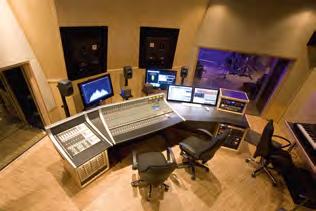




SOMMER CABLE based in Straubenhardt/Germany was founded in 1999 and is now one of the leading suppliers of professional high-quality cable and connection technology with a focus on the audio, video, broadcast, studio and media technology sectors. The product range including the in-house brands HICON, CARDINAL DVM and SYSBOXX covers cable bulkware, connectors, connection cables, individually adaptable distribution systems and electronics.
A B2B shop with over 25,000 products is available 24/7.




KLANG:konductor is providing immersive in-ear monitoring at New Life
NEW LIFE UNITED PENTECOSTAL Church of Austin has upgraded to a KLANG:konductor system to facilitate its growing I/O count. Also known as New Life Austin, the church became one of the first houses of worship in the country to implement a pair of KLANG:fabrik immersive in-ear monitor mixing processors in 2017.
The tech-forward church originally installed the KLANG:fabrik systems to improve the performance experience for the 8–10 musicians and vocalists on its stage every Sunday; however, over the years the number of performers has grown, putting a strain on the system’s capacity. “We have nine or 10 vocalists during services now, along with bass, drums, a couple of guitars, keys, percussion, sax and so on,” said TJ Feronti, New Life Austin’s tech director and FOH engineer, who noted that his channel count now exceeds 70.
Alongside the KLANG:konductor system, New Life Austin has also installed a DiGiCo Quantum 225 to replace its previous DiGiCo SD9 console, purchased through Heart of Texas Music. “We had been maxed out on the DiGiCo SD9 console we had been using for front of house and to route the monitors,” explained Feronti. “Now, we have up to 128 channels and 16 separate mixes available, going over MADI through the Quantum 225. It’s all so much easier to manage.”
Feronti noted that the church’s musicians and singers have taken to the
KLANG’s immersive mode, with most of them choosing to use it. “They’ve been very impressed, whether they’re new to the professional aspect of this or have been doing it since they were using wedge floor monitors or just stereo IEMs. They love being able to move things around spatially in their mixes on their iPads and have them reflect what they’re experiencing onstage.”
Meanwhile, Brentwood Baptist Church has updated its audio infrastructure with a KLANG:konductor immersive in-ear processor. Located in Tennessee, the church underwent a complete refresh of its audio, video and lighting systems, working with AVL systems integrator Diversified. Brentwood Baptist technical services director Darby Gilmore commented on the update: “We were not only due for a technical refresh but an aesthetic one, too. We wanted to modernise and the KLANG:konductor was part of that.”
Tim Corder, Diversified’s vice president of faith and performance, brought the KLANG:konductor to the church’s attention, seeing it as a versatile solution able to toggle from full orchestra and choir one week to a high-energy, rock-style band the next. “Brentwood Baptist has a very diverse, multi-generational worship style. It can be a challenge to adapt a sound system for that kind of diversity. So, they needed a platform that could manage high channel and stereo-output counts, would have an

easy-to-use interface and also sound great. KLANG is the only one that checks all those boxes,” he explained. Corder specified that the Apple iPad employed as the user interface with the KLANG:konductor be hardwired for PoE, to assure uninterrupted power and broadband connectivity for every use. “It’s been in use now for nearly a year and it’s been flawless,” he said.
The KLANG:konductor is integrated with Lawo mc236 MkII consoles at front of house and monitors. “The console has several 64x64-input MADI interfaces and we’re using two of them for a 128x128 input matrix,” commented Gilmore, adding that the vocal team preferred having the personal touch of a monitor engineer, so they decided to go with a console and a KLANG:konductor. He also noted that the KLANG:konductor’s interface with the console was straightforward and effective.
“We can use the KLANG alone for the backline on smaller events and use both for full services. That way, everyone has the benefit of the KLANG’s audio quality, and it gives us tremendous flexibility in terms of how we allocate our monitor resources,” he said.
The KLANG:konductor is controlled using a VNC remote-desktop connection to a computer running KLANG:app, giving the team control access from the console through that interface. “We also have access to KLANG:app via a number of KVM remote stations so we have a high degree of submixing control and a tonne of routing options. Diversified had suggested that and it’s been working flawlessly,” remarked Gilmore.
www.brentwoodbaptist.com www.heartoftexasmusic.com www.klang.com www.newlifeaustin.com www.onediversified.com

meyersound.com/panther
The latest chapter in the evolution of Singapore’s St Andrew’s Cathedral has added the art of dreaming to the mix
LOCATED NEXT TO CITY HALL, St Andrew’s Cathedral is one of the largest churches in Singapore. Although the current building was constructed between 1856 and 1861, a church has existed on its site for almost 200 years. Having made the decision to upgrade the sound system in the main sanctuary, the cathedral turned to a trusted familiar partner to help them in late 2023 in time for the Christmas festivities.
Following a comprehensive AV overhaul in 2005, the cathedral experienced a series of audiovisual upgrades throughout its halls over the following 18 years. Many of the works – including the adjacent new sanctuary – were conducted by Illuminate Productions and Lambda Acoustics.
“I have had an association with the church since I was a child and our company has been a long-term partner of St Andrew’s Cathedral,” explains Illuminate Productions’ director, Timothy Huang.
Illuminate Productions has been involved in system upgrades in the prayer halls, in addition to supporting high-profile events such as its bicentennial celebrations and, more recently, the installation of Dr Titus Chung as the new Anglican archbishop for Southeast Asia. The company’s extensive experience in both systems integration and live event technical production has created an enviable client list. “Events for churches –such as the Tribal Gathering in Malaysia as well as livestreaming
and live album recordings for Christian groups such as Awaken Generation and Josh Yeoh – have given us a unique ability to help churches improve their systems and workflow to align with the best practices in the industry,” furthers Huang.
Bizarrely, Huang’s close affinity with St Andrew’s can almost be viewed as spiritual intervention.
“I had a dream one Saturday evening in July 2023 about the cabling at St Andrew’s,” Huang imparts. “The following morning, I requested if I could look at the cabling possibilities and was told that the contractor would be filling in the trenches a day later, but I would be allowed to add further cabling if warranted.”
Electronics & Engineering Pte Ltd (E&E) oversaw the infrastructure of the cabling and engineering for the restoration. Despite having accurately completed this fulfilment, a late change in the audio design – from
part active/part passive to fully passive – meant the amendments had not been accounted for. “In comparison to the 2005 upgrade, the proposed re-design included more speakers, thus requiring more cabling,” continues Huang. “I therefore re-ran the cables for the speakers so they would provide futureproofing should additional speaker points be needed.” As a result, four extra points were laid behind certain columns should they ever need to be activated during full house events.
According to Huang, the conversations and actions that followed stimulated the remainder of the AV upgrade, including the PTZ cameras and the AV-over-IP and Dante audio networks.
“ T he speaker system was stipulated for enhanced speech intelligibility, although some contemporary services are held in addition to live music during weddings and events,” furthers

Huang. Except for the upper altar area incorporating legacy JBL loudspeakers, St Andrew’s is now adorned with a distributed passive column solution using d&b audiotechnik components.
The troublesome acoustics and reverberant reflections within the iconic Gothic architectural landmark remained a challenge during the loudspeaker modelling.

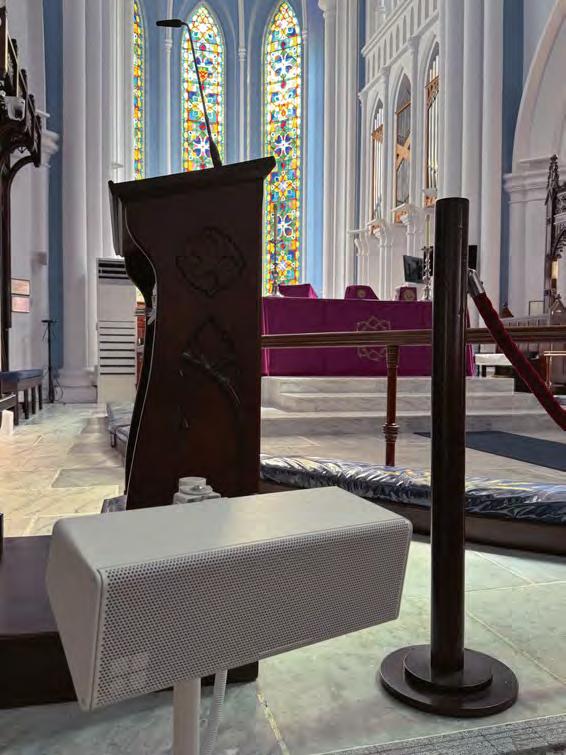
Specified for its directivity and slim profile dimensions within the heritage site, the d&b audiotechnik loudspeaker system comprises 24 enclosures finished in white to blend into the interior design. Consisting of six 4-inch neodymium drivers arranged in a cardioid setup and an HF array comprising six 1.1-inch tweeters to create a horizontal dispersion of 90°, the 24C model was specified as the main and delay columns at the front of the nave. Two smaller 16C columns are deployed as secondary delays. With two 27S installation version cardioid subwoofers providing low-frequency enhancement, the side and front fills receive even coverage thanks to 14 44S columns fixed in pairs down the length of the cathedral.
A single 10D amplifier powers the main speakers and subwoofers, while five 5Ds provide ample headroom for the remainder of the aluminium column outputs. Operating over the Dante network, DSP settings and scenes have been saved in the amplifier’s processing software. “Our design utilises three rows of 24C and 16C column loudspeakers to cover the main section of the nave with two units of 44S loudspeakers providing front-fill coverage on the chancel steps for the first few pews up front,” explains

Huang. The HF array with a vertical dispersion of 20° can be adjusted constantly between 0° and –14° to target audience listening areas. The beam produced by the low/mid drivers is tilted downwards by 5°, offering directivity down to 370Hz.
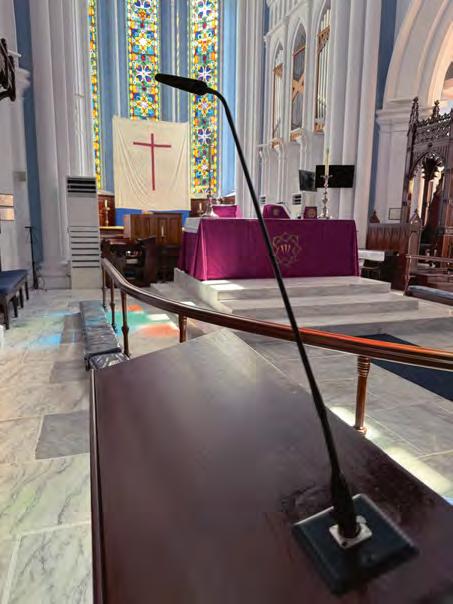
The scene is set at the west porch entrance, where visitors are greeted by audio emitting from a pair of 8S weatherresistant coaxial loudspeakers fixed to the frame. Once inside, the interior audio system takes over displaying an evenness of coverage. “Two units of 27S cardioid subwoofers have also been placed at the sides of the chancel steps for musical events that require added lowend reinforcement,” comments Huang. “To ensure even coverage throughout, 12 units of 44S loudspeakers have been added to the sides of the nave. By installing these highly directional loudspeakers, the modelling confirmed increased distribution and coverage, leading to reduced reflections and an improvement in the overall acoustics within the nave.”
The microphones have also been refreshed with Sennheiser ME36 shotguns placed into the two pulpits. “There is good rejection on these models, the condensers
are sensitive and the dynamics work well,” explains Huang. Having suffered RF issues with the previous setup, Illuminate Productions has installed a UA844+SWB signal wireless booster along with three channels of Shure QLXD4 operating Beta SM58 handhelds that transmit wirelessly without interference. Combining separate pairs of diversity antenna connections for multipurpose rooms, a fourzone RF Venue active antenna combiner simplifies multi-zone wireless microphone connectivity. For both speech and musical services, Illuminate Productions has also supplied a small-format Allen & Heath SQ-6 console with a Dante card into the rear production area. Illuminate custom-programmed the audio control surface with presets, user EQs and advanced routing to help make life easier for the volunteers. The visuals are enhanced with a fixed PTZ camera system combining three Canon N500 models at the rear and close to the altar, with one smaller Canon N300 camera located on the side walls. Digitally enhanced, a 40x zoom can be applied for close-ups on the altar.

Managed by a Canon IP100 controller, a Blackmagic Design Atem 2ME production switcher receives video inputs for outputting to a network of Samsung 43-inch screens. Most of the displays are fixed

to pillars where views of the altar are restricted. In addition to integrating a new cabling infrastructure, E&E installed the visual outputs throughout the sanctuary in addition to two Furman CN-3600SE power sequencers that are required for surge protection and one-touch powering up and down.
“I’ve been a part of the church since I was a child,” furthers Huang. “This project was a major undertaking, and the recent restoration works served as a one-in-100-years event. It was vital we lay the right cables at the outset.” Having laid additional cabling in August, final installation of the speakers taking place in November and tuning completed early December, a packed works schedule ensured the project was completed in time for the Christmas Eve celebrations. Fine-tuning took place in February 2024, with d&b audiotechnik’s APAC office assisting as they had throughout the upgrade.
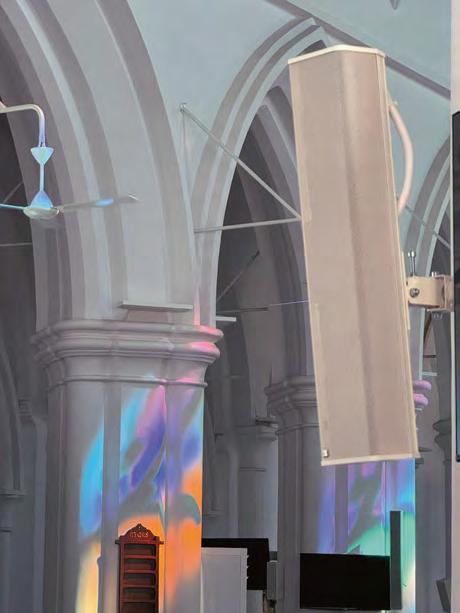
12 units of 44S loudspeakers have been added to the sides of the nave
“Having made some minor adjustments, the operator now benefits from tighter control, particularly when the church is full.” As with previous upgrades in the cathedral, Illuminate Productions’ thorough preparations including its 3D renderings of the space ensured the works were ultimately successful. “The d&b setup
we proposed for this type of space seems more appropriate,” concludes Huang. Somehow, dreaming is believing.
www.cathedral.org.sg www.dbaudio.com www.enepl.com.sg www.illuminate.sg www.lambda.sg







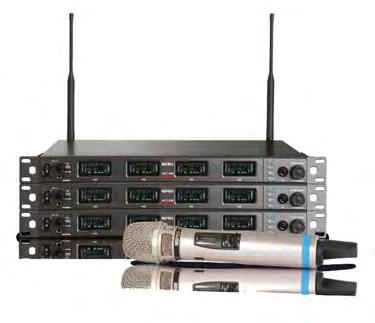

As more contemporary elements have been added to its services, Hanam Presbyterian has once again turned to a Meyer Sound system to ensure intelligibility throughout the large fan-shaped auditorium
CONSECRATED IN 1963, HANAM Presbyterian Church welcomed its first worshippers to a small house fitted with a modest altar in Seoul’s eastern suburb of Gyeonggi Do. With growing numbers, the church invested in a 1,700m2 plot of land where it continues to interact with the community.
With rising membership, the church added audio components to fulfil the criteria of intelligible sermons and prayers. As a more contemporary order of service has become integrated into the Sunday service, musical services demanded sound reinforcement together with visual enhancement. Today, Hanam Presbyterian is regarded as a leading church for its worship, praise and Christian culture. Incorporating best-in-class media, lighting and stage design for its slick, stage-managed services, the extensive house of worship is further equipped with internal and external broadcasting courtesy of its IP networking and cabling infrastructure.

The spacious fan-shaped sanctuary extends to almost 180°
Posing a challenge to sound designers, the spacious fan-shaped sanctuary extends to almost 180°. Resembling an indoor amphitheatre, the architectural design demanded a dispersed loudspeaker placement to enhance the clarity of the pastor’s
message. In addition to the wide layout, an audio solution was required to ensure intelligibility could be provided for the deep under-balcony seats. Following extensive acoustic treatment, reverberation times and reflections have been mitigated.
Having faithfully served Hanam Presbyterian for almost 15 years, the loudspeaker system comprising Meyer Sound CQ-1 speakers and 700HP subwoofers at FOH was earmarked for an upgrade. “In addition to providing world-class

audio, Meyer Sound’s self-powered speakers eliminate the need for a dedicated power amplification room,” comments Hanam Presbyterian’s systems manager, Kim Hyunsoo.
“The exceptional delivery of the spoken word and praise in a church setting played a crucial role in the decision to invest in Meyer Sound in 2009. The reliability of Meyer Sound equipment was reaffirmed during the following years that have passed.”
Having insisted on retaining a Meyer Sound loudspeaker system, the church requested a demonstration by the California manufacturer’s Korean distributor, Ingang Audio. Before the proposed speaker system could be set up for valuation, consultation with the Hanam Church officials took place during which the desired audio requirements and aesthetics were considered. The room dimensions, acoustics and other parameters were then input into MAPP 3D modelling, and a Lina loudspeaker solution was proposed and unanimously approved. Delivering high-frequency

Each L-R array comprises eight compact Lina modules and dual 750-LFC elements
The dual 6.5-inch Lina and 15-inch 750-LFC combination is digitally managed by dual Galileo Galaxy 816 processors, which incorporate corrective room equalisation and fine-tuning. Capable of producing 138dB SPL of high peak power, Lina’s compact 515mm-wide profile also passed the church’s requirement for a minimal footprint.
Despite the favourable coverage by the L-R Lina loudspeaker system, the fan-shaped room layout coupled with the deep under-balcony seats demanded fill speakers to be integrated into the design. Focusing their energy towards the seated area to the left and right of the stage, Meyer Sound Ultra-X40 cabinets provide side fill. Combining with the Lina modules to deliver a uniform voicing and response towards the lateral walls, each dual 8-inch cabinet is equipped with a rotatable 110° x 50° Constant-Q horn.
The under-balcony seats required a slightly less powerful loudspeaker solution to complement the FOH
two Ultra-X20 speakers are installed as L-R fill for the upper balcony. The Meyer Sound upgrade is completed with a stage monitoring system comprising MJF-208, UM-1P and UM100P wedges.
Supplied by SamaSound, an Allen & Heath Avantis console now performs both FOH and monitor mixing. Integrating two HD touchscreens, the 96kHz 64-channel mixer includes a dPack software upgrade package for added dLive processing. With Continuity UI, the production engineers and volunteers can operate between the physical controls and the onscreen software, including gains and pans on the rotaries, or EQ or dynamics across the whole strip at the touch of a soft key switch. Operating within the Everything I/O ecosystem, the console is paired with a 48-in/16out GX4816 audio expander and is also compatible with the ME series of personal mixers and IP remote controllers. In addition to FOH/monitor splits and multitrack







An exhibition-style lighting solution was required to showcase the blending of the three religious faiths at the Abrahamic Family House in Abu Dhabi
THERE AREN’T MANY SITES ON the planet where a variety of faiths all come together to celebrate the multi-disciplined nature of worship. Dedicated to the pursuit of peaceful faith coexistence for generations to come, the Abrahamic Family House (ABH) on Abu Dhabi’s Saadiyat Island is certainly an impressive oddity.
The complex has been designed by world-renowned Ghanaian–British architect Sir David Adjaye OM OBE, who specialises in public architecture, creating symbolic buildings designed to tell stories. At its heart are a mosque, a church and a synagogue – designed of equal stature, size and materiality to eliminate any sense of hierarchy. The mosque is oriented towards Mecca, the church towards the east and the synagogue towards Jerusalem. The architecture is beyond impressive, each building a 30m-high cube of bush-hammered concrete, standing atop an expansive limestone plaza.
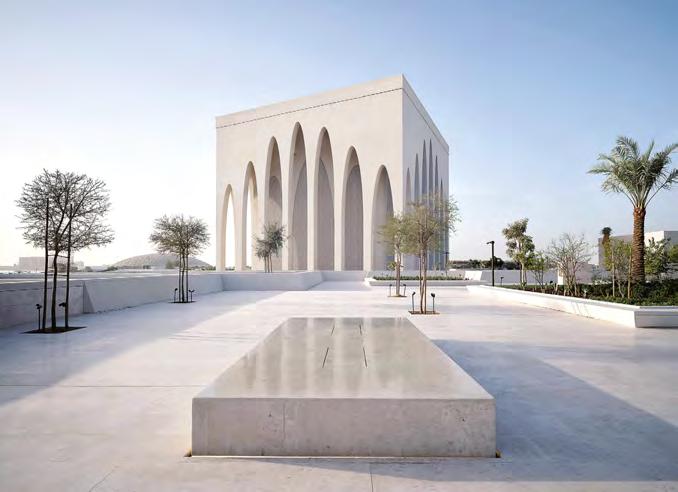
up into multiple zones with each presenting something different.”
The first installation, Faith, comprises 11 dynamic, petalshaped AV screens that showcase different life events in the religious journeys of Islam, Christianity and Judaism. The second exhibit, Word, focuses on the three respective holy texts of Islam, Christianity and Judaism, showcasing nine extracts from the Quran, Bible and Torah. The final installation, Place, explores the relationship between religious spaces and faith. Here, immersive screens incorporated into a plinth and the ceiling depict different prayer environments, like the Sheikh Zayed Grand Mosque.
“When you first enter the complex, to the right of the reception is the story of the ABH,” furthers George.
The primary aim of the ABH is to bridge man’s common humanity through the exchange of knowledge, ongoing dialogue and the practice of faith. Beyond
the three landmark buildings that initially grab the eye, the real magic lies within. Nestled between the mosque and church is a welcome area that connects to a multi-use exhibition space. The entire area serves as an educational centre, with guests taken on a journey through various immersive exhibits.
“The exhibition area serves as a common space where guests can
experience aspects of all three faiths together – it’s a showcase of how the UAE has welcomed all of these different cultures together,” explains Triangle Power Solutions senior project manager, Liz George, who has been involved in the project since the early days.
“There’s an area called the Oculus, where they showcase videos accompanied by music. It’s split
“Next, you’re directed inside a dark room with showcased projections of various prayers. After this, you move through another dark room illuminated with religious symbols and finally end at a magnetic wall onto which visitors can pin their wishes or goals. Within the Word exhibit, a show runs where every 30 seconds a different sermon plays, cycling through the various

faiths. Here, we integrated gobos that highlight the accompanying sermons by projecting Muslim, Jewish and Christian symbolism across the walls. It’s a nice story, and from the visitor perspective it’s all one integrated experience.”
Triangle was tasked with specifying an exhibition-style lighting package throughout these areas that would augment the audiovisual system construction by XYZ Technologies. “Initially, we became involved in the project through the consultant directly and were supplied a concept from the lighting designer,” recalls George. “But as the project progressed, there were several design changes made, and this is where the Oculus space came in. XYZ was tasked with providing the AV integration throughout this space, and so we worked closely with them to incorporate the lighting package.
“They came up with the concept of using AV to trigger the show control because there’s a range of audio cues and video projections happening at the same time. They wanted it so that when an Islamic prayer comes on, for example, the

and all these kinds of things. That was the initial concept, and we had to integrate with the wider system over IP in order to synchronise everything. This was done using a server called Isaac – it gives us UDP commands, and we take those commands and use them to trigger different scenes within our system.”
Illuminating these exhibition spaces are more than 200 Prolights products from the manufacturer’s EclDisplay DAT and Wash ranges –flexible LED spotlights specifically designed for museums, galleries,
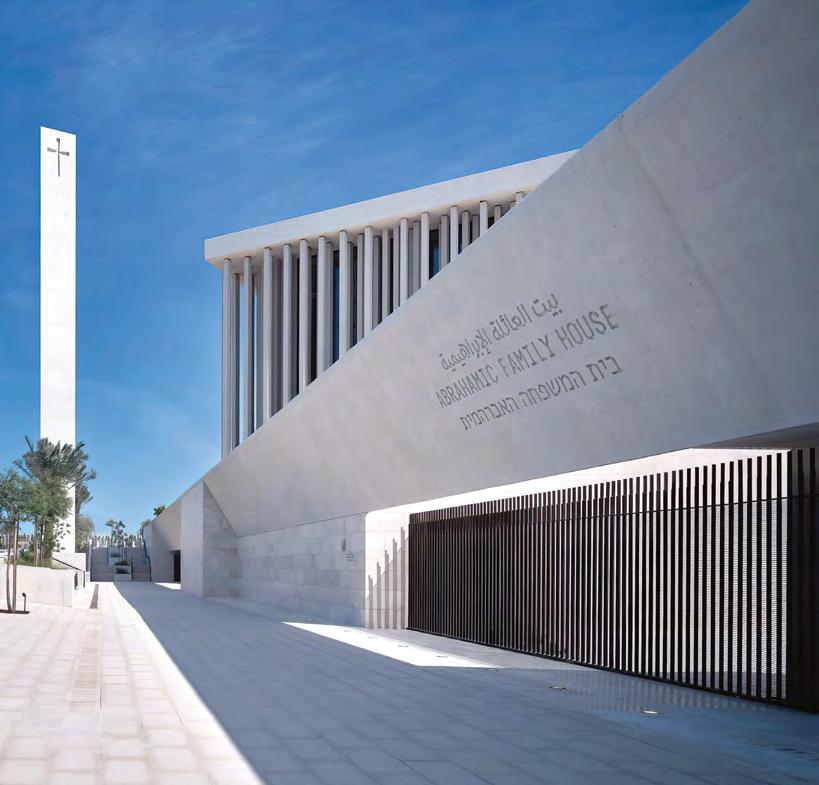
ceiling mounted,” says George. “We particularly like the flexibility of the products. They offer multiple options from RDM to DMX and DALI. We also have several kinds of lenses that allow the same unit to function for spot and gobos, plus they are really perfect for integrating colour changing. You can load the gobo with locked accessories that help to tell the story of the project.”
“Right from the start of this project, Triangle warmly welcomed collaboration on finding the best solution,” offers Akram Abdelbaki, PRO LAB business development manager. “Honestly, I’m thrilled and satisfied with the results, and it brings me a sense of pride to have played a part in overcoming the challenges of this project.”
retail spaces or any public venue where a classical-looking fixture is needed alongside several control options, sources, optics and brightness levels.
In total, 69 EclDisplay DAT 30K, 64 EclDisplay Wash L2550 and 31 EclDisplay RZL2040B zoomable profiles illuminate the exhibits.
“The beam angles differ in each area between 25–50° and 20–40°, and they are installed in a variety of configurations depending on the ceiling, mounted on lighting tracks, ceiling clamped or directly
As has so often been the case off the back of the pandemic, one company’s loss is another’s victory. “Originally, a different manufacturer was specified by the consultant for the lighting – he was quite biased to using only this specific brand – however, they were experiencing serious issues with chip manufacturing and shipping delays of well over six months. We were forced to explore alternatives, and this led us to Akram and the team at PRO LAB who proposed Prolights. We took some samples to give to the consultant, performed a range of tests and, ultimately, got everything approved for use. By the time we completed that process, the consultant had become convinced that the Prolights fixtures could match or exceed everything promised by the original brand.”
“Our goal is to go beyond aesthetics, symbolising unity,” adds Rami Haber, CEO of PRO LAB. “Through thoughtful design and functionality, we strive to offer an integrated and enriching experience for visitors of all backgrounds. We’re honoured to contribute to the Abrahamic Family House’s ambience.”
This new relationship is already beginning to pay dividends on future projects. “Since trialling the fixtures on this project, we’ve gone on to use them again or specify them at several more important sites, such as the Natural History Museum,” concludes George. “The Abrahamic Family House site itself is also unique, and we are very proud of our company’s involvement in bringing it all to life.”
www.prolabllc.com
www.prolights.it
www.triangle-ps.com
FOUNDED IN OCEANSIDE IN 1798, Mission San Luis Rey church, known as the “King of Missions”, is one of 21 missions originally built by the Spanish in California. Today, it’s seen as one of the finest examples of Spanish colonial architecture and a national historic landmark that Franciscan Friars call home.
San Diego-based AV company Sound Image Integration, now part of Clair Global Integration, has been servicing the mission’s audio, camera and video distribution requirements for the past 20 years. When a decision was made to reorientate the interior of the mission, from its traditional long rectangular shape, through 90°, to bring the congregation – which can reach 1,200 worshippers – closer to the altar, Sound Image Integration’s business development manager, Scott Coyle, recognised that “while it made more sense that way, the sound was compromised due to a
the audio setup was required, it was the Martin Audio Torus T820 constant curvature solution that Coyle proposed, bearing in mind that with the reconfiguration, the church now had extraordinary width but little depth. “We knew the focus needed to principally be the spoken word,” he says. “However, at the same time, they have large congregations attending their weekend masses when a full choir and band perform.”
Together, Coyle and the mission looked at the space and reviewed the types of speakers that would serve best for clarity, coverage and budget.
“Having undertaken several projects with Martin Audio over the years in the house of worship space, Torus was our recommendation. Based on our long-standing relationship, I knew we would have their trust,” he explains. An approach was made to Martin Audio product support engineer, Will Harris, who duly set to work on a design. “When [the church] saw the visualisation and coverage map of how


Harris continues: “With such a beautiful and historic building, I knew that the minimal visual footprint would be needed to get this done right and the Torus T820 really fit the bill. We were able to get them tucked away within the architecture of the building.”
Delivering high output from an 8-inch speaker within a compact footprint, it is the 100° x 20° (HxV) dispersion pattern that makes the Torus T820 suitable for the shortthrow requirement within the space. L-R flown pairs flank a central cluster of four T820 elements, while out wide on each wing, wall-mounted Martin Audio CDD10s provide optional out-fill reinforcement, generally depending on whether the choir is in session. SX112 subwoofers warm up the sound and fit into the existing cut-outs in the ceiling, while the entire rig is powered by a pair of matched iKON iK81 eight-channel amplifiers.
With classical and baroque architecture, the installation needed to be undertaken with the upmost sensitivity. “Once our engineering team had purpose-manufactured the
rigging points, the system went up easily.”
When it came to fine-tuning, Coyle said they were fortunate that the room was not as live as is typical in what he terms as “an A-frame type of scenario”. Harris undertook final commissioning. “When he fired the system up, he looked at his screen, smiled and said, ‘This is why I love these boxes!’” adds Coyle. “Testament not only to the box but to our installation craftsmanship. This was a perfect project for the Torus 8. The constant curvature systems just work so well together delivering even and seamless coverage across the entire room, while handling the entire frequency spectrum with very little effort.”
Kerey Quaid, the mission’s music director, agrees wholeheartedly. “The new speakers and amplification system are a great improvement for both music and spoken word in our worship space. We have both clarity and bass for the first time, and equally good sound for the whole congregation.”
PROFESSIONAL
HK Audio’s COSMO line array system combines state-of-the-art audio quality with ingeniously simple handling, utmost utility and remarkable economy to provide an extremely flexible, easily configurable PA for professionals.
COSMO raises the performance bar for line arrays, setting a whole new standard for productivity and efficiency. Integrative and versatile by design, it delivers measurably higher effective SPL in the HF range than comparable systems.
With horizontal directivities of 100°, 80° and 60°, this formidable family of ultra flexible systems provides the bandwidth needed to cover the most diverse live scenarios.

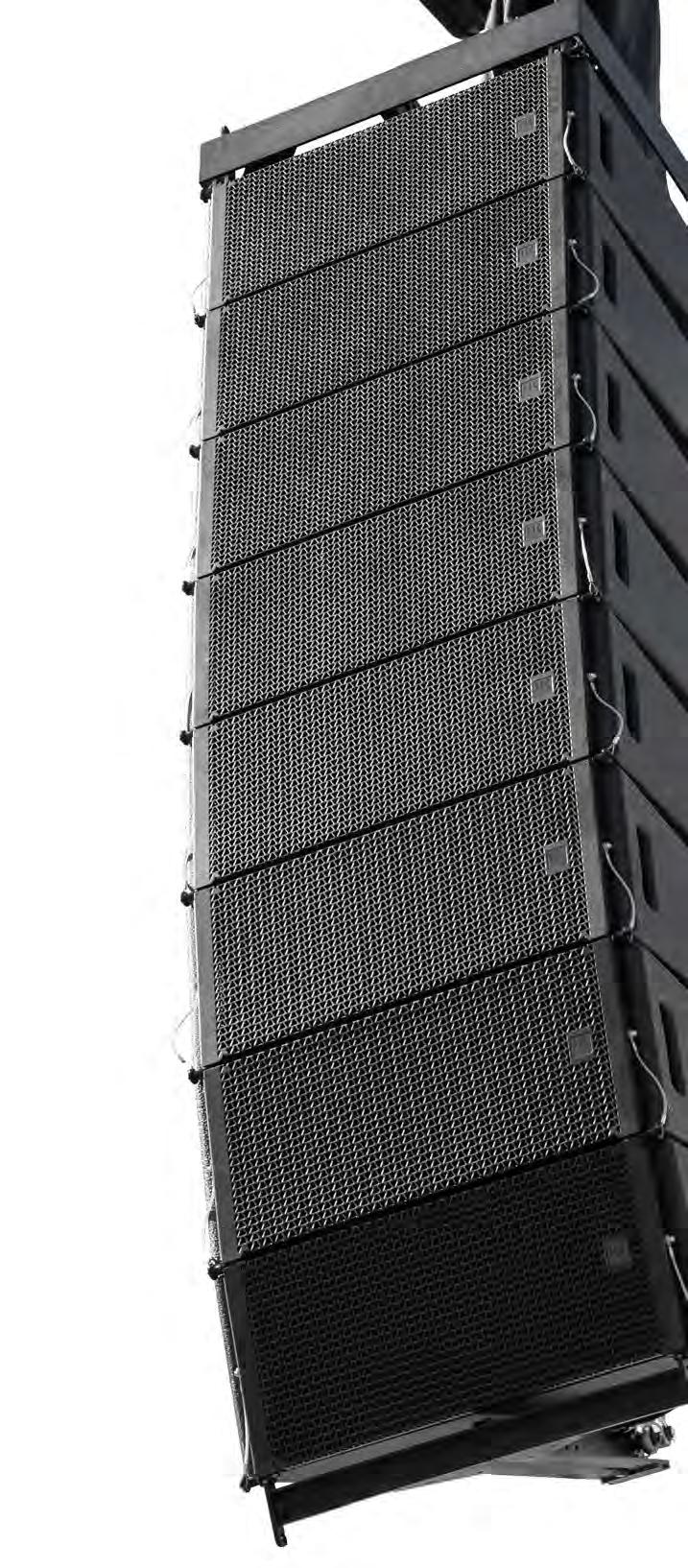

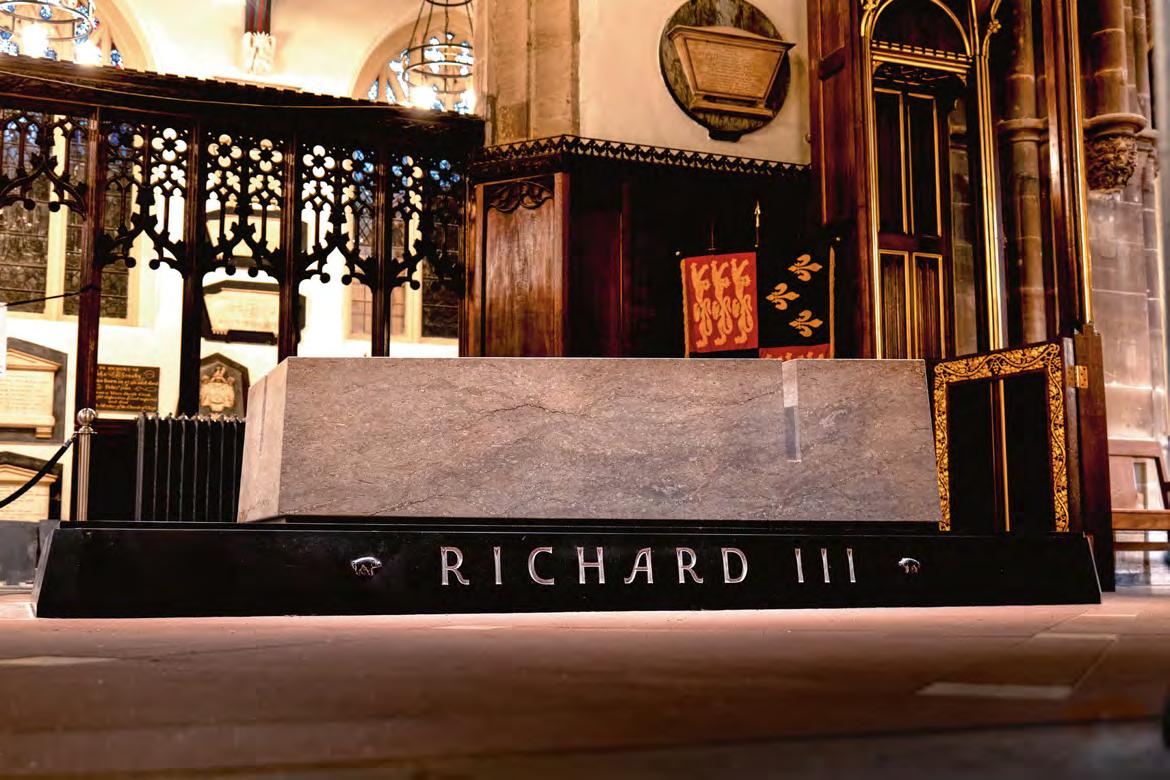
Leicester Cathedral has reopened its door to worshippers – and tourists – after a £12.7m restoration project
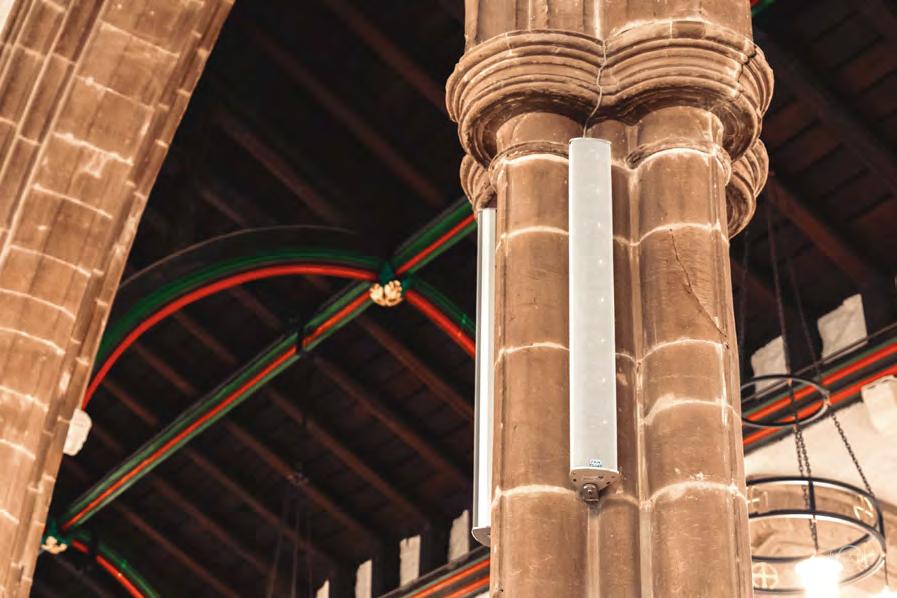
2014. “The cathedral contacted us to say that their audio system was
broken and they needed a new one,” explains Phill Beynon, director at NoiseBoys, which has been active in the HOW sector for over 14 years. “They had about three systems all on top of each other but nothing was working very well – it wasn’t fit for purpose and the cabling had broken down.
“Despite everything that was happening with Richard III, the cathedral desperately needed a working setup so, just before the reinterment, we fitted some AKG radio mics and four Pan Acoustics Pan Beam PB 04, three PB 16 and two PB 08 steerable columns throughout the cathedral with a BSS BLU control system. It’s a comprehensive setup as the cathedral has one large main space but also multiple side chapels and they wanted to be able to conduct a service in any one of those spaces that could be heard throughout the cathedral. It’s the fourth smallest Anglican cathedral in England so it doesn’t have a big, long nave
but, with all the side chapels, we had to fit just as many speakers because they’re all firing around one central point, but the source can be anywhere in the cathedral.”
Since 2015, the cathedral has been firmly on the map as a tourist destination and the number of people wishing to visit the burial site has increased significantly over the years. In January 2022, the cathedral closed its doors for nearly two years to undergo a £12.7m (US$16.2m) project to restore stonework, windows and ceilings, provide a new – and, more importantly, a more accessible and level – stone floor with underfloor heating and create an additional


of keeping everyone organised and on time,” explains Beynon. “For us, we encountered hardly any problems because we were mostly redoing what we’d already done before – it allowed us to understand what the problems might be before they occurred. And the good thing about this project was there was such a long design phase that you could iron out any issues while they were still on paper. We’ve carved out a bit of a niche in the heritage sector and we really enjoy doing these kinds of projects. It’s great to be able to put quality audio into a building that was never necessarily designed for reinforced sound – and make it look invisible as well.”
project a few years later to take down the equipment they had originally installed. “Normally, you put in a system and it stays there for 20 years and you don’t hear from them again,” laughs Beynon. Shortly after the cathedral closed its doors, the NoiseBoys team began the process of dismantling the audio system it had installed back in 2015 and storing it until the renovations were complete.
With most of the cabling fitted in early 2023 and additional cabling fitted underneath the new concrete floor laid in May 2023, the Pan Acoustics speakers were the first piece of equipment to be reinstalled a couple of months later in July, some 18 months after they’d been taken down. “We started off with installing new cabling, then after a bit of a gap we went back and put ends on those cables. When everyone else had finally finished, we went back to
commission the system and make it sound as good as it had before.”
The entire restoration project was led by building contractor Messenger so the integrator didn’t have the luxury of being the only trade onsite. “We had to work around the lighting people, the electricians, the underfloor heating specialists, the stonemasons, the concrete pourers, the archaeologists – it really was a proper building site. We were responsible for running all the data cabling for everybody so we had to coordinate everyone’s wishes and integrate everything alongside all the cabling we needed as well. It was a very long design process – I’ve been on the cathedral design team since we first started work there in 2015.”
However, one bonus of the closure was that it gave NoiseBoys the opportunity to make some improvements to the audio system it had installed in 2015. “Our job
this time round was actually smaller than back in 2015 as we were reinstalling the previous system and making a few upgrades as well,” continues Beynon. “The whole system is now based around Dante and NDI, and we’ve replaced the BSS control system with an Allen & Heath AHM setup. The AHM gives them everything they need to control a standard service on one tiny fader bank or an iPad, without any complicated controls.” As part of the refit, NoiseBoys has also installed a video system comprising a large, 4m-wide, double-drop projection screen, an Epson 16K EB-PU2216 projector and reinstated three Birddog PTZ cameras for recording and livestreaming through a vMix system they previously sold to the cathedral during lockdown. Leicester Cathedral finally reopened its doors on 26 November 2023. “Messenger did a great job
And that’s not the end of the story. A new heritage learning centre is currently being built on the side of the cathedral which will house an exhibition and space that schools can use to teach about the history of Leicester. “We’re just in the process of finalising the AV design now which includes screens and speakers so that they can host educational events and receptions in there if they want, with some touchscreens and projection in the classroom. It’ll all be on the same network as the main cathedral – using IP protocols ensures that everything we’ve done inside the cathedral can be extended really easily into the new space.”
With King Richard III finally resting peacefully in his new tomb in the centre of the cathedral, it looks like there’s no rest in sight for the NoiseBoys team with the extension project likely to be completed towards the end of 2024.

WHEN PAYING OUR RESPECTS to departed friends and family members, funerals are naturally sad occasions. However, for Malaysian Ralph Gomez, one farewell led to audio enlightenment. As a committee member of the Catholic Church of the Assumption in Petaling Jaya, Gomez left a funeral service in Singapore with a burning desire to convince his fellow church members what their services required sonically.
Built in 1980, the original audio system that had faithfully served the Malaysian church’s services for over 30 years had been earmarked for an upgrade. “I attended a funeral at St Joseph’s Church in Singapore where I paid little attention during the Mass as I was trying to see where the audio was emitting from,” recalls Gomez. “When a four-piece choir was performing, the hairs on the back of my neck were standing up as the church was flooded with sound.”
Challenged in locating the unobtrusive column loudspeakers, he took a photograph of the loudspeakers once directed by

Pre-exisiting Bose speakers have been repurposed as balcony monitors for the choir
Father Joe Lopez Carpio. Returning to Kuala Lumpur, an excited Gomez called his friend and DJM Systems technical director Daveston Ahimaz (Dave). “I was adamant that we had to purchase this loudspeaker system because our existing Bose speakers couldn’t be serviced as parts were no longer available. With the side glass windows and opulus ceiling design, the acoustics within are challenging, so we required a specialist solution. Therefore, I tried to convince the committee that the church required a total audio upgrade with the speakers that I had heard and requested to make a presentation for them.”
The unobtrusive, compact column loudspeakers that had made a big impression on Gomez were manufactured by US brand, RenkusHeinz. As part of the Iconyx series, the slim 155mm x 175mm form factor of the IC24-R-II enclosures has made the aluminium enclosures an iconic fixture for almost two decades in applications demanding speech intelligibility, a musical dynamic range and an almost invisible touch.

Operating within a 120Hz–18kHz frequency range, the 24 4-inch coaxial transducers contained within the 2.84m-high enclosure are powered by individual Class-D amplifiers. With the softwarecontrolled DSP, up to 12 steerable beams can be individually shaped and aimed from a single IC24-R-II column, with the inherent advanced beam-steering technology providing control down to 250Hz.
The church had a limited budget for the upgrade, so Gomez soon discovered that the price tag associated with the Iconyx speakers was an issue. “I was adamant that we needed these loudspeakers for our church. In addition, I engaged Dave to become a fully fledged member of the committee, hence waiving his consultancy fees. However, the cost of the new speaker system was a hard sell to the committee because they basically didn’t understand the technology, despite explaining why the beam-steering solution would make a big difference. They requested a consultant, as they wanted to make a comparison with other solutions available on the market.”
Enter Dave. “Ralph took the effort to conduct a huge fundraising programme, including a dinner and a golf tournament,” recalls Dave.

remained sceptical – until the day they heard the loudspeakers during a demonstration. At that point, they appreciated why we had made the efforts to convince them it was the best system for their needs. “
An order followed and Mercoms Systems Sdn Bhd supplied the

column speakers, two under-stage Renkus-Heinz CX118S 18-inch subwoofers are powered by a QSC RMX4050 amplifier to extend the low frequencies to produce a fullrange audio system. “Currently, the music during services is restricted to just a guitar and keyboards. But
aesthetics perspective that we only required two loudspeakers, because they are very accurate and provide even coverage.”
In addition to the front-of-house audio, there is a rear mezzanine floor, outdoor and back-of-house areas. Lack of budget perhaps or more



but sustainable green values are evident with repurposed components that operate as new, despite dating back to the 1990s. Powered by a QSC C1400 amplifier and managed by a pre-existing Bose ControlSpace 5100 processor, Bose speakers fulfil choir monitoring on the mezzanine level. Two wall-mounted Bose speakers have also been repurposed to provide pastoral monitoring on the main stage, backed up by a QSC Powerlight amplifier.
“Despite these speakers being approximately 30 years old, the components have not degraded,” reveals Dave. “For a 3.25-inch poly cabinet, it’s remarkably heavy and well made.” A new ITC loudspeaker system consisting of 27 enclosures, however, was specified and installed for the outdoor front entrance, left and side walls in addition to the interior back-of-house areas. Like the rest of the loudspeaker system, three T-77240Z IP terminal zone amplifiers provide the power in 8Ω operation. The audio, video and lighting production teams preside over their control surfaces on the same balcony where the choir and musicians perform. From here, all the video signals are transmitted down to the back-of-house area. Enabled by a D-Link DGS 1016C GigaByte switch,
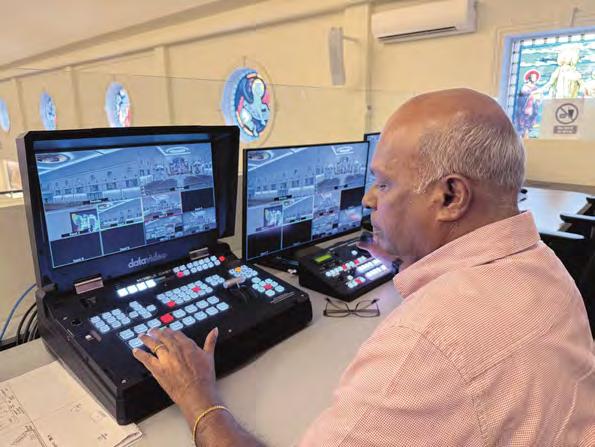
below the floor, to a rear room underneath the altar,” confesses Dave. “The microphone inputs –including Shure BLX wireless and two AKG goosenecks mounted on AudioTechnica 8668 stands – are also fed to the same room below the altar. “To the contractor’s dismay, I adopted a broadcast standard infrastructure for the church, as this will endure for years to come.”
entrance and under the stage.
These main outputs receive their HD signal from a Datavideo MobileCast HS-1300 six-channel portable video streaming mixer. Inputs include three Datavideo PTZ cameras managed by a Datavideo RMC-180 PTZ controller and a PC with lyrics and images. Aten Van Cryst eight- and four-port HDMI splitters complete the video signal chain.
the ITC networked amplifiers.
coloured conduit casings downstairs from the mezzanine balcony along the left and right sides of the church
To the left and right of the main stage, visual assistance is enhanced by two wall-mounted LED screens in addition to smaller

“We opted for a six-channel Datavideo mixer because it allows us to record the entire production as well as livestream,” explains Dave. “For recording a wedding or a funeral, we can livestream directly to YouTube or Facebook using a standalone Blackmagic Design Atem Mini. The signal is fed from a connector inside the church, but we possess an external clock and a microphone point for outside for special events, so it operates as a portable production unit. With the Blackmagic Atem Mini, I retain the main outputs to the screens, but I can livestream at the same time.”
Today, Gomez testifies that the church has become something of a flagship in Petaling Jaya. “Today, during Sunday services, some worshippers from other churches attend solely to hear the RenkusHeinz audio system,” declares Gomez. “It’s wonderful seeing them looking for the outputs and being astounded by the power that two unobtrusive columns provide when I point them out. It reminds me of myself 18 months ago when I attended St Joseph’s in Singapore. I am happy that I attended the funeral as it ultimately turned out to be a good demo.”
www.assumptionpj.org
www.djmsystems.com
www.mercoms.com
Create meaningful experiences when your audio is accessible to everyone.


Provide a Choice
Patrons can choose how they access audio; their own smartphone, or venue-provided receiver.
Seamless Guest Experiences
New beacons provide location-based audio for an automated and seamless experience.
Virtually No Latency
No lip-sync issues! Low latency means the audio does not lag.
Easy to Use
Simply turn on the device, select the channel, and adjust the volume.
Bluetooth® Enabled
Connect to the audio using wireless headphones, earbuds or hearing aids.
T-Coil Friendly
ListenWIFI is compatible with t-coil enabled hearing aids and cochlear implants.

Visit Listen Technologies at www.listentech.com/listenwifi to learn more.

Promedia Solution has equipped Bogor City Grand Mosque with an audio distribution system to provide intelligibility to prayers and speeches
IT HAS BEEN A STOP–START affair for the Bogor City Grand Mosque but, following nine years of paused construction, the latest landmark of the colonial capital of Java is finally open. Late works including the completion of some interiors and landscaping in addition to the 35m-high Menara (minaret) overlooking Bogor City Square remain, but the main doors have been opened and the local Islamic community has gravitated to the mosque. Having turned on the newly installed audio distribution system, the Imams, Azans and teachers are now stimulating worshippers with powerful teachings and prayers.
Following a successful tender to design and build the audio system for the Bogor Grand Mosque, Promedia Solution was called to site in late 2023. Since its inception in 2007, the Jakarta-based distributor has attracted a large clientele amongst Indonesia’s charismatic churches. Less musical in nature, perhaps, clarity of speech remains an overriding and critical requirement within mosques. Tasked to add power and intelligibility both to the

Promedia Solution managing director, Yosua Yan Heriyanto. “Prayers,
sermons and educational lessons need to reach the congregation clearly.
Whether at the Mihrab, the Minbar, in the main hall or the courtyard, the teachers need to focus on the message rather than the microphone, or the loudspeaker processing settings.”
The Promedia Solution team ensured that the voice of the Imam would reach every worshipper clearly, both within and outside the mosque.
“Mosques are complex buildings, with big domes and challenging sound environments,” furthers Heriyanto.
“The acoustic aspects in Bogor had to be carefully considered during the design phase, to ensure echoes and longer reverberations were eliminated. Acoustic simulations ensured that no architectural aspects were overlooked.”
With the bulk of the loudspeaker and network cabling installed beforehand, the Promedia Solution team focused on fixing a distributed loudspeaker system into the fabric of the main hall.
A combination of Electro-Voice EVID 5-, 6- and 8-inch wall-mount speakers inside the mosque cover the main and balcony levels. EASE modelling
pinpointed the exact locations for the mounts. Assembled and ready for use, the mounted system provides 90° rotation horizontally or 45° vertically. To maintain uniform coverage throughout the listening area and paying close attention to echo and feedback suppression, the EVID-S5.2, -S6.2 and -S8.2 two-way cabinets have been individually fixed at appropriate dispersion angles.
A more focused audio solution was required for the Mihrab. This has been achieved by installing four EVID-C6.2 6-inch ceiling speakers above the low ceiling. With views across southern Bogor towards the Gunung Salak volcano, the Menara has been installed with 8-inch models of the same series. The inputs and outputs may be adorned with EV badges, but a Dynacord heart beats within the mosque’s audio powerhouse. Powered by a combination of single- and dualchannel C2800, C1800, C1300, L2800 and L1300 DSP amplifiers, the loudspeaker outputs are routed to an MXE5 matrix mix engine. Optimised for both 24/7 low-impedance and 100V

A wall-mounted EVID distributed audio system provides even coverage across the entire main hall
operation, speaker processing with FIR Drive technology is an integral feature of the amplifiers. With 12 analogue mic inputs, eight line outputs and 24x24 Dante channels, the MXE5 matrix mix engine serves as a control centre for system devices and offers


their personally voiced loudspeaker
Mounted to the wall behind the Mihrab, and connected by a single PoE network cable, a Dynacord TPC-1 touchpanel controller serves as the audio interface. Featuring a highdefinition 5.7-inch display, the HD touchscreen allows the Imam to focus on the service instead of the technology. In addition to fast system setup and flexible system control, the loudspeaker system can be comprehensively monitored remotely by the Promedia technicians in Jakarta.

Although front panel amplifier displays provide local control and management of the individual amplifiers, the inclusion of Sonicue system control software excludes the Imam’s touch. Presets for various users have been programmed to
The settings for the individual voices are mixed on the control surface of a Tascam Sonicview 16 console connected to a SB-16D stagebox. Integrating Dante networking, the 16-input digital mixer features a 32-bit/96kHz multichannel USB audio interface and built-in multitrack SD recording. The Tascam theme is extended with a Tascam TM-95 18-inch gooseneck microphone recently routed into the Minbar. In addition, the Imam and the instructors can conduct calls for prayer and teachings using several Electro-Voice wireless PL801 hand-held microphones transmitted to R300-HD receivers.
Completing an audio project on budget

A gooseneck microphone serves the Imam at the Minbar
integrators. However, the distraction of a spreadsheet can often impair the audio quality and ease of functionality required by the client. To master all these demands is a skill that cannot easily be taught.

There are a variety of assistive listening solutions on the market to suit the needs of people with hearing loss
ORGANISED BY THE WORLD Health Organization (WHO), World Hearing Day took place recently with the aim of overcoming the challenges people face as a result of societal stigmas surrounding hearing loss. Global bodies and audio equipment manufacturers are working hard to try and battle against the misperceptions and negative mindsets that hard-ofhearing people are still facing. Contacta, Listen Technologies and Ampetronic are three such companies that are developing products that provide worshippers with clear and accessible audio. Forming part of the Allvida accessibility group of companies, Contacta Systems, Listen Technologies and Ampetronic are rooted in their respective missions to make clear audio accessible. Listen Technologies believes everyone deserves an exceptional listening experience and offers solutions that overcome the challenges of noise, distance, clashing conversations and hearing loss to deliver clear audio in any setting or environment. Family-run Contacta was established in London in 1970,

but soon developing into assistive listening solutions. Its ethos is to design products that create more inclusive environments for people with hearing loss.
While there are numerous assistive listening products available for a variety of scenarios, the most common systems found in houses of worship are hearing loops, infrared (IR) or radio frequency (RF). A hearing loop (also
currently the only technology that delivers the sound direct to users’ hearing aids, via the built-in telecoil coupler, without the need to use any other device. It is also the only technology that offers latency-free sound transmission and, crucially, the only technology that has a globally accepted installation standard.
IR systems use invisible light to carry audio signals wirelessly

Contacta’s new RF range
receivers. Transmitters flood infrared light into venues so that the required area is covered, allowing users to pick up an audio signal using a range of IR-compatible receivers. These systems are ideal for venues where confidentiality is important or users need to move between areas with different sound sources. RF systems use wireless radio waves to transmit sound directly to listening options such as headphones or inductive neckloops. Signals can be transmitted through walls, glass partitions, ceilings or other obstacles.
“Radio frequency-based systems are ideal for very large houses of worship and outdoor venues,” explains Kim Franklin, vice president of global marketing at Listen Technologies. “Infrared systems are helpful in situations where confidentiality is critical, such as small group meetings or confession, and when concurrent events are happening in adjacent spaces. This is because light cannot pass through walls so there is no chance of audio spill-over from one space to another.”
“At the moment, hearing loops are still seen as the superior technology for large venues like places of worship. Congregants
can link into the sound wirelessly, just by pressing a button on their hearing device,” adds Avril Mayes, sales executive at Contacta Systems. “They don’t have to ask for additional equipment. Once a large area loop is installed, there’s very little upkeep other than maintenance checks on a yearly basis. An RF system’s transmitter and receivers need charging; however, if you want to move your RF setup to another location, there are portable options. The choice of system will depend on the space for which the assistive listening system is needed and factors that could impact on the strength of the audio signal. But the great thing is that there’s a system available for every venue that will give users clarity and inclusion.”


Listen Technologies has created a System Recommendation Tool to help venues select the right assistive listening technologies and systems to meet their needs based on criteria such as application, building and seating capacity.
Mayes. “That’s followed by a site visit by one of our trained engineers, who will determine that the system we recommend not only meets the client’s budget but ultimately provides an optimal experience for hearing aid wearers.”

Houses of worship can use this tool to determine which type of technology and system would best meet their specific needs now and in the future. The tool asks a series of questions such as whether a venue needs a stationary/installed or portable assistive listening system, what an audio distribution system will be used for and whether privacy is an issue.
“Our initial meeting with a client is to fully understand their requirements, the characteristics of the space and the audio sources
Listen Technologies’ ListenIR, ListenRF and ListenTALK assistive listening systems feature receivers that worshippers can borrow. They then connect their own or venue-provided headphones and earbuds to the receivers and listen to church audio. Ambient noise is filtered out so only clear audio is delivered to their ears. If worshippers wear telecoil-equipped hearing aids or cochlear implants and the house of worship has a loop system, the audio will transmit directly to their telecoil-equipped
does not have a loop installed, worshippers can use a neck loop with a receiver to receive the audio directly to their telecoilequipped hearing aid or cochlear implant. The manufacturer also has a BYOD (bring your own device) assistive listening solution that lets worshippers use their smartphone as an assistive listening receiver. They download a free app, connect to the church’s Wi-Fi network and stream audio to their smartphone.
Contacta has recently upgraded its RF range which includes stationary, portable and handheld transmitters, a portable receiver, ear-worn, lapel and headset mics, and drop-in chargers. The new range offers improved sound quality and transmission range with a built-in Hi/Low power selector to increase range when needed. It includes multiple custom charging options and a range of microphone, listening, charging and mounting accessories.
However, it’s not just people with either mild or severe hearing loss that can benefit from assistive listening systems. Anyone can experience situational hearing loss in noisy environments or when they are located far from a speaker.
“With assistive listening systems, ambient sound filters out so only clear audio is delivered directly to a listener’s ears via headphones or earbuds connected to a receiver,” adds Franklin. “It does not matter if listeners wear hearing aids, nor is it necessary that they wear hearing aids. Hearing sermons and music clearly during worship services, despite distance, noise, acoustics, language or hearing loss, can help congregants feel more engaged and offer a better listening experience.”
stigma surrounding hearing loss, people may be shy in exposing their disability but, with greater awareness and use of these technologies, we can help to overcome that and ultimately help people feel more comfortable,” explains Mayes. “And our products aren’t exclusively for people who use a hearing device – if you’re in a particularly loud environment, products like our RX-30 rechargeable loop listener enable anyone who struggles to hear to benefit from these systems.”
Whether congregants have hearing loss, occasionally cannot hear clearly or find it difficult to focus on audio when there are distractions, assistive listening systems can help. “Assistive listening systems are easy and affordable to install and deliver tremendous benefit to users,” adds Franklin. “When worshippers hear clearly and have a positive listening experience, they may feel more engaged and inspired at worship and more likely to return to church.”
“It’s all about inclusivity,” concludes Mayes. “Anyone can be a worshipper and anyone can have hearing loss. It’s a subject people don’t like talking about but, with signage showing a worshipper that there’s a hearing loop in place, anyone using the system can do so without the person sitting next to them knowing. Worship is a totally different experience if you can’t hear clearly so we need to ensure that everyone – whether they have hearing loss or not – is coming away with the same positive experience.”
www.contacta.co.uk
www.listentech.com
WHEN THE PANDEMIC WOKE
everyone up to the reality of having congregants at home rather than in the sanctuary, there were houses of worship that already had the infrastructure in place to get content out to their viewers at home. For others, it was a bit of panic to say the least – but they managed – collectively church members put their thinking caps on and, with an iPhone here and a small camera there, they managed by capturing or developing a way to livestream, whether it was some level of software support or other hardware so they could go online.
During and as we emerged from the pandemic, churches everyone really – came to acknowledge that the hybrid world that we live in is here to stay. While most churches now have some form of streaming setup, there are some out there that are still relying on their iPhones and cameras to connect with their stay-at-home worshippers.

“Because audio is a critical factor in the production process,” continues Porterfield. “It’s so important that audio is addressed otherwise viewers will turn off. Each house of worship will be at a different point with their audio –some will be trying to implement Dante while others are still using a basic analogue setup. Often, I’ll have to adjust the streaming solution I’m proposing depending on the quality of the audio system currently in place or suggest recommendations to improve quality and reliability.”
So where to start? “What we are still seeing is churches that might have a camera but it’s positioned right at the back of the room with the pastor onstage feeling like he’s miles away to the viewers at home, so we need to get back to the first point, which is education and what we like to refer to as the principles of production,” explains Porterfield. “There are now really good resources online to tap into that are free or paid. MxU is one service providing an all-in-one training platform that allows any church technician to get more experience on video and audio – and also lighting – so that they can learn how to design and set up a their production supporting the livestream. However, often what happens is that somebody at the leadership level – or e ven the pastor – is trying to do this themselves and it’s too much for them to take on. It’s important that churches use the resources that they have available to them in the congregation – someone that has a skillset or is interested in the opportunity to help contribute towards the service each week.”
However, there are varying degrees of skill in church communities so the other option to consider is keep the setup as simple as possible when starting out. “It can be as easy as setting up a decent pro camcorder to a Blackmagic ATEM Mini Pro, or sometimes we’re now seeing simple solutions from companies like YoloLiv with their Ultra
product or Magewell’s Director Mini where you can plug an HDMI input and stream from a box that allows you to add graphics. So, I think there’s different solutions that can help enable a church to maybe stream to different platforms or a single platform service of choice and but still have something that looks good and hopefully sounds good.
From a technology perspective, network becomes another critical factor. Often smaller churches will need to talk to their local internet provider to ensure there’s enough bandwidth for streaming or uploading content. “We are now seeing more options for backup if their primary internet provider goes down with companies such as LiveU – their Solo Pro encoder has a local network connection as well as bonding capabilities that leverage the cellular services with their own special software setup in case of internet failures, and it even has its own battery.
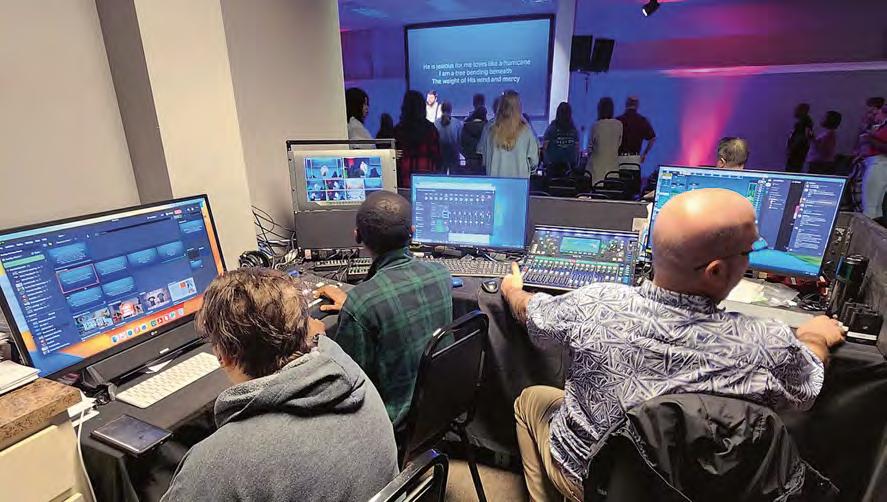

However, when houses of worship have got to the point that they’ve got a good audience on Facebook or YouTube, then it’s potentially a good time to upgrade. “Facebook and YouTube are monetised platforms with advertisements so you might want to remove that disruption from your services,” continues Porterfield. “Churches often decide that they just want their congregation to see their message and their content, not content from a third party. This is where platforms such as Onestream and Boxcast come into play. But the tech team needs to be ready to move to the next level and be experienced enough to manage that change effectively. I call it the crawl, walk, run approach – it’s important that the change doesn’t become counterproductive and that the team doesn’t feel overwhelmed.” At the other end of spectrum are churches that have multiple production stations – a CG station which could be Pro Presenter or Proclaim with graphics, a station for the audio team and then a station for the video production setup with solutions from Ross Video, larger Blackmagic products such as the ATEM Television Studio HD8, OBS being used for
that process where your CG graphics can be driven from a different source via the internet, so now we’re talking about putting everything in the cloud. That’s the big goal that I’m currently working on a lot in the industry at the moment. I’m working with LiveU and Epiphan and many others in the community at large in taking something that’s onsite and offloading it into the cloud. This becomes an option for houses of worship that don’t have anyone on the team that has the technical knowledge but there’s money in the budget to pay somebody else to do this remotely. We saw this in the pandemic where people were running productions from their homes. But we’re talking more at mega church levels here.”
However, it doesn’t matter where a house of worship is at with its streaming – Porterfield believes in the importance of providing tools to support a variety of different needs onsite, all the while thinking about the future and where the church can go next. “The biggest challenge is working out where to start and then planning a road map with the ministry to achieve it. It goes back to education and fostering a community of interaction so that even if a church isn’t ready to make that
YoloLiv, Resi and Boxcast are doing the same thing – they have a way of dealing with network fluctuations to make sure that the stream is consistent and it’s not dropping out. But where I’m working a lot at the moment with mid-sized to larger churches is how to help them manage that remotely. So as churches grow, we’re seeing solutions introduce cloud control from Epiphan, LiveU and others where we can now talk directly to the encoder itself. So, we become this co-pilot with the church or its ministry.”
In terms of the most popular setups, Porterfield frequently sees churches using either Blackmagic and now YoloLiv to stream into Facebook or YouTube, or if a church needs to stream into more than service or content delivery network, then restream.io or Onestream are becoming a good place to star t. “These options give you a little bit of everything,” he explains, “so that you can build a streaming workflow that allows you to send to multiple areas. Onestream, for instance, allows you to drop a video onto

your website, but you can also have pre-roll or a simulated live playback, and there’s also a tool where you can customise your own landing page for an event and have a countdown to the service, etc.”
graphics and lower-thirds and allin-one production solutions from Vizrt. “But the budget now goes up,” explains Porterfield. “You’re creating a whole different level of production and we’re virtualising
decision, there’s an awareness and we’re helping to communicate where they can go to when they’re ready for the next step.”
social180group.io
John Black looks at some of the resources and theories that can help achieve a well-lit stage
with each of the elements of a lighting system and how they work together, let’s look at how to approach laying out the lighting grid or rig to light your stage. This can be referred to as the distribution of lighting instruments – choices made as to the direction from which the light illuminates the stage or subject. There are a number of different situations you may encounter when approaching the layout of your lighting grid. It may be that you are in a facility that already has permanently installed lighting positions distributed around the auditorium. All of the circuitry and pipes/trusses may be fixed, dictating where you can place instruments. While this may seem limiting at first, one benefit is having all of the power and data cable distribution available all of the time to each position (hopefully). Alternatively, you could be in a facility that is equipped with rigging points and temporary lighting positions flown using chain hoists and trusses. This provides the maximum flexibility in that instruments can be redistributed from event to event depending on the stage configuration and lighting needs. The power and control cables to fixtures may have to be run each time the rig is set up, but otherwise you have complete flexibility. Ideally, your facility may use both permanent positions and temporarily flown positions, allowing you the benefits of both. In any of these situations you will need to make choices as to the distribution of your instruments. While there is no single “right” way to distribute your instruments and light a stage, there are a lot of resources and theories that can guide you towards achieving a welllit stage.
Having published A Method of Lighting the Stage and A Syllabus of Stage Lighting in the 1930s, Stanley McCandless is considered to be the father of lighting design and his
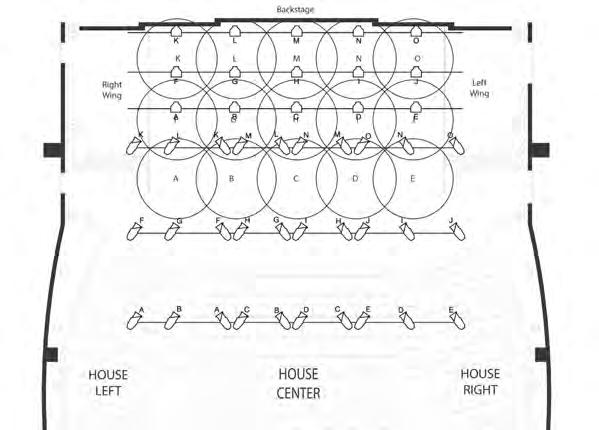
Example of a three-point lighting layout
method – the McCandless Method –is still one of the most popular theories on lighting design and the process of distributing instruments. McCandless’s theory divided the stage into smaller areas to be lit, all between 1.8–3.6m in diameter. Each lighting area is then lit by two instruments from the front, each of which are positioned 45° above and 45° to the sides of the centre of the area to be lit. This is known as front lighting. A third instrument is then placed behind or high overhead the subject and is known as back lighting.
Consider for a moment placing a single instrument directly in front of a subject. The result is that the subject will appear flat and two-dimensional because all natural shadows are washed out. McCandless’s goal was to more closely mirror lighting as observed in the real world. Using his method of two front instruments positioned at an angle, natural shadows that define features and provide modelling will still exist and help provide three-dimensionality to the subject. Each of these front instruments would have colour
applied – one warm colour and one cool colour – that would blend together to provide natural lighting. With the addition of a backlight, the subject is given further modelling and will “pop” out of the background more.
To lay out the lighting grid using the McCandless Method, these three lighting positions will be applied to each of the lighting areas. If your stage is divided into six lighting areas for instance, you would plan on 18 instruments to light the entire stage area. Also referred to as three-point lighting, this method is lighting distribution at its most basic. It provides good lighting coverage that appears natural and provides modelling over the entire acting area, but it does not take into consideration the lighting of backdrops, scenery or other specialised lighting needs.
Before thinking to yourself that the McCandless Method doesn’t have anything to do with lighting in a house of worship setting, let’s look at how it is still applied today. Many worship facilities use video recording, streaming, broadcast and/or image magnification (IMAG), all of which benefit from lighting techniques with ties to Stanley McCandless. This can be seen through the concepts of key light, fill light and backlight, all of which are commonly used and understood terms with photographers and videographers.

Three-point
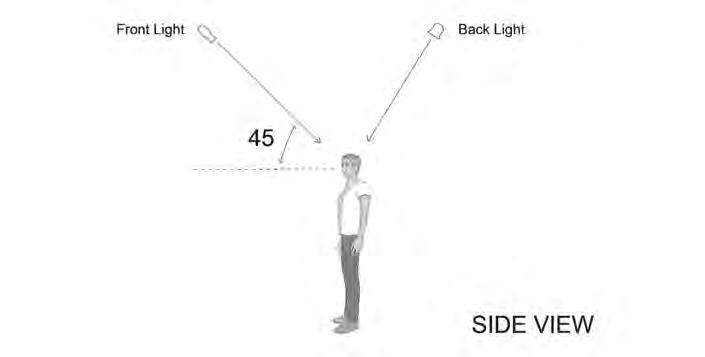
The key light is the main light used on a subject and is often the brightest. As the dominant front light, it is often placed at a 45° angle to the camera, though different positions can be used creatively to create different effects. The fill light is the second front light and is used to fill in some of the dark shadows created by the key light. It should not be as bright as the key light and create additional shadows, but rather just soften the contrasts while allowing some shadowing for modelling. Finally, the

backlight creates a glowing edge around the subject and pulls the subject out from the background, further ensuring that the subject doesn’t appear flat.
Building on the McCandless Method, many designers use larger lighting layouts using four- and fivepoint lighting methods. Of course, this means even larger instrument quantities are needed, but is argued to result in even more realistic lighting results.
The reason I began with the McCandless method is that subject visibility is often one of the most important considerations in lighting design in houses of worship. Also, worship staging typically doesn’t have extreme scenic changes – backgrounds, backdrops and band setups may change, but mostly speakers and the use of the presentation space remain the same. Therefore, once a good lighting layout for primary lighting is set up, it generally can stay that way for long periods of time.
You can begin using a scale drawing of your facility or, if one doesn’t exist, you can physically tape out the stage into your lighting areas – each of which should be between 1.8–3.6m in diameter. These will be the areas for which you will plan out the positions of your lighting instruments. Starting with the two front lights, locate a lighting position at roughly 45° vertical angle and 45° to the left and right of the centre of your lighting area. These will be your two front lighting positions. Ellipsoidal spotlights are most commonly used as front lights, and the lens degree most suitable to your specific situation will vary depending on the throw distance between the instrument and the lighting area.
Next, locate the position of your backlight. It will be centred with the middle of the lighting area and positioned on a steep angle from behind or high above. Backlight instruments are often Fresnels, PAR/flood fixtures or LED wash instruments and often are also used as a colour wash on the stage. One consideration for backlight instruments is that you
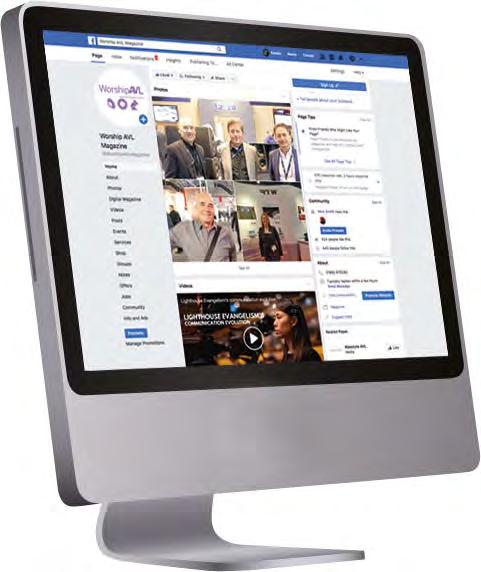
may want to prevent the ability for the audience or cameras to see into the lens as it can be uncomfortable to the eyes or create lens flares (though this can also be an intentional, creative effect). To avoid this, make sure that the backlight is either at a very steep angle, hung very high above the stage or use barn doors to mask off the visible part of the fixture lens.
You will need to go through this process for each of your lighting areas to create a uniformly lit stage using this three-point lighting method. If you are working in a facility that has had a lighting designer involved in the design process, chances are you will find these positions easily. If positions at these angles aren’t possible, don’t worry – find positions that are as close to them as you can and use those. Many facilities are less than ideal when it comes to lighting positions and you may have to do some experimentation in terms of placement to model subjects as best as you can.
Another important consideration for houses of worship is being able to create moods through the use of coloured lighting on the stage as well as in the auditorium. As previously mentioned, often the backlights in the lighting layout can be used to create the stage wash, but you can also supplement with additional instruments as needed. Most often stage colour washes are set up in backlight or toplight positions, and often use LED wash instruments. Washing the stage in colours can affect how the audience feels and can powerfully
reinforce what is happening on the stage – or distract from it.
Texture added to the stage floor, scenic elements or in the air (when using a hazer) can add visual interest to the lighting design and environment as well as add depth. Texture is created through the use of patterns or gobos. Ellipsoidal instruments used to be the workhorses in this area, though they have become widely replaced with automated spot instruments capable of carrying large quantities of gobos. Additionally, these instruments can often animate gobos, add colour to gobos, resize gobo projections through zooming and be programmed in movement cycles to add even more interest. Often this is the visual “eye candy” we think of when attending a concert. These instruments are often placed in backlight, toplight, sidelight or positions on the stage deck itself.
Once your subject is visible and you can evenly light your stage area, the rest is up to your budget, system capabilities and your creative vision for how you want the lighting to look. Lighting design is a layering process – combining colour, texture, movement and distribution in ways that create moods and atmospheres to support the event or story being told. We’ve only scratched the surface of how to begin approaching it through the use of McCandless’s tried-and-true method. But always be willing to experiment and try new methods as each facility is unique.




How do time misalignments between main and sub systems affect perceived sound quality?
systems employ a combination of full-range speakers and subwoofers to deliver a consistent sound pressure level (SPL) over the audience, while maximising the frequency bandwidth. Time alignment between the main (full-range) and sub (subwoofer) systems is generally required to ensure an efficient summation at low frequencies. A recent study conducted by L-Acoustics investigated how time misalignments between the main and sub systems affect the perceived sound quality, and makes for interesting reading for those seeking a deeper understanding on the topic.
“We have investigated for quite a long time the topic of subwoofer positioning in terms of efficiency, homogeneity of the distribution and noise pollution for outdoor events,” explains L-Acoustics’ field application
research engineer, Thomas Mouterde. “Our study tackles this question in terms of alignment with the main system. Moreover, a good main/sub alignment is crucial to create a consistent frequency response for the complete system.”
The team conducted a listening test where participants were asked to rate the sound quality as a function of the relative delay between main and sub systems. Participants were also requested to qualify the nature of the perceived artefacts using spectral or temporal attributes. It is crucial to configure these two systems to be time-aligned and effectively combine with each other at the crossover frequency. However, in situations where the audience area is large, the distance between them can result in significant variations in the relative timing of the
emitted sound waves depending on the listener’s position.
“Main and subwoofers systems are usually well time-aligned but, when the two are physically separated, the alignment is optimised only at a few locations,” adds Mouterde. “The idea of the study was to investigate how much the alignment is perceived in this area. More specifically, to understand how the perceived quality changes as a function of the time delay and to understand the associated perceptual dimensions.”
The team conducted a listening test outdoors, with the speakers stacked on the ground to avoid the notch that would be created by the reflection on the floor at ear height with the flown subwoofers. Two combinations of main/sub systems from L-Acoustics were selected to represent the variety of equipment used in medium
or large-scale sound reinforcement applications.
The smaller system consisted of four KARA II full-range loudspeakers (main) combined with two KS21 subwoofers (KS21_100 preset).
This main-sub combination has a crossover frequency of 73Hz.
The larger system consisted of four K2 full-range loudspeakers (main) combined with three KS28 subwoofers (KS28_60 preset). For this system, the crossover frequency is 52Hz. The loudspeakers (full-range and subwoofers) were connected to LA12X amplifiers that were fed by AVB audio signals sent from an RME Digiface AVB audio interface connected to a laptop.
The experiment was conducted with one participant at a time, with the sound pressure level set by the organiser to be loud enough to hear
changes induced by misalignments at low frequencies but remain comfortable over a one-hour test session (≈ 81dBA). A panel of 23 expert listeners aged between 25 and 55 participated. Most were members of L-Acoustics R&D staff, with or without past professional experience as mixing or system engineers in a live sound context.
The results showed that overall, adding a delay to the reference mainsub alignment lowers the perceived quality of the summation. However, the perceived quality is not a linear function of the delay but oscillates depending on the main-sub phase relationship.
Two different types of degradations impact the quality perceived by listeners: spectral and temporal degradations. Spectral degradations consist of a loss of energy around the crossover frequency. Degradations of this type can be perceived for relatively small delays, but their intensity depends on the main-sub phase relationship.
In terms of temporal degradations, it was expected that there would be a loss of temporal precision and the perception of two distinct sources. Surprisingly, the study found that the loss of temporal precision is

not perceptually relevant. Both temporal and spectral degradations have an equally negative impact on the perceived quality of the sound.
Listeners perceive two sources mostly when the sub system is early relative to the main system; however, the intensity of spectral degradations doesn’t seem to depend on the delay direction.
“The study shows that the alignment quality can quickly be perceived as poor in parts of the audience area if integrators don’t pay attention to the subwoofer positioning, even if the calibration of the system has been properly made,” notes Mouterde.
The results of the perceptual test demonstrated that the perceived quality is mainly driven by the perception of both a loss of energy around the crossover frequency (spectral degradation) and a temporal separation of sources (temporal degradation). Spectral degradations are perceived even for relatively small delays and their perceived intensity oscillates as a function of the delay. Temporal degradations are perceived for longer delays and are typically experienced when the sub system is early relative to the main. Both degradation types appear to equally impact the overall
perceived quality and result in a non-linear relationship between delay and quality. In the light of this, the following system design recommendations can be made: place the subwoofers as close as possible to the main speakers so that the two systems are well-aligned over the largest possible audience
“This study clearly concludes that placing subwoofers as close as possible to the main system is the best solution from the alignment point of view,” says Mouterde. “This therefore has consequences in terms of system design that integrators should pay attention to. For example, house of worship venues can often be strange shapes. Wide venues can clearly be particularly affected when main and sub systems are horizontally separated (with a stereo system and a central subwoofer, for example) and is something for integrators to bear in mind.”
www.aes.org
www.l-acoustics.com
The full version of the study can be accessed at: www.aes.org/tmpFiles/ elib/20240320/22366.pdf

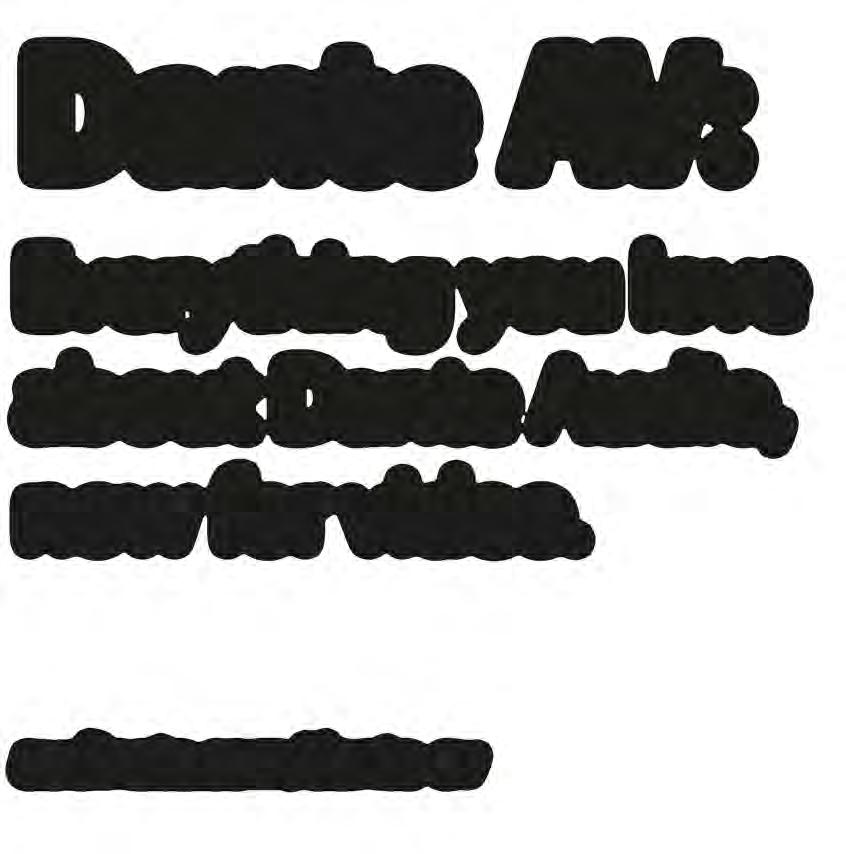

Casey Hawkins hopes to take his own advice and buy the best he can afford
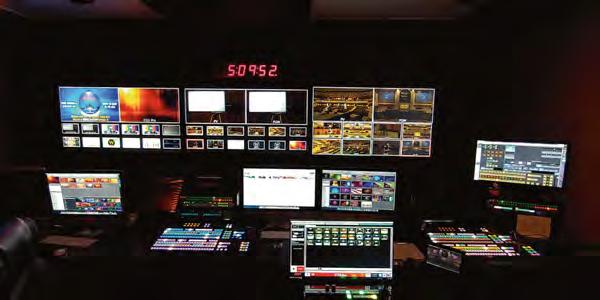
I AM NOT SURE HOW TO TITLE this article. I could call it “Don’t buy cheap”, or I could call it “Keep your eye on that thing”. Perhaps I could even call it “Save yourself some big trouble on Sunday”. Well, whatever it gets called, the message here today is to make sure you are careful when choosing your backbone equipment. Recently, I have written articles on backbone infrastructure like routers, patch fields, etc. Today, I get to write about something that happened to me last week. It was perfect timing for my article and, quite honestly, I might say it was actually “perfect timing”. Perhaps that should be the name of the article.
Three things that I could quickly identify as issues you absolutely could not overcome on a Sunday morning are 1) a backbone router failure, 2) loss of your house sync and 3) failure of your main switcher. You can still almost have a show with any other failure. You could get by with cameras and no graphics. You could get by with audio and no video, or video and no audio. You could get by without some of your cameras. But lose your ability to route, or sync to all your gear or the switcher that
brings it all together and you probably have no show.
Last Thursday, before I left work for my normal weekend of Friday and Saturday off, I noticed that I was receiving black video from our CrossWalk Conference Center via fibre to the worship centre control room. I require our operators to leave colour bars with a bouncing box online whenever there’s no event going on, in order to prove lines are operational. But sometimes they forget, so I throw them a bone, as I began to do Thursday. Then one of my staff members came through and advised me that all the IMAG TVs in the hallway of CrossWalk were in black, and that the switcher multiviewer was all black as well.
Well, I knew that meant something more than a simple oversight. Recently, we had a UPS that needed a new battery as it was beeping, so I thought maybe we were having another issue with a UPS or another power situation.
But, when I got over there, I was not happy at all with what I discovered. We had a power issue all right. Our main backbone router had failed. Both power supplies were dead. And this unit has internal power supplies. With a big, huge roll of my eyes and a deep sigh, I knew this needed to be resolved before Sunday or we would be out of business for the Español Church service we have in that building on Sundays. It is a new service that launched this year,
so it still has a lot of critical eyes focused on every detail. So, I knew this was not a time for my ministry to fail. Not that there ever is, but you know how there are those “special” times where you can’t fail? It was nearly five o’clock, so I had to text some team members in order to set a time to meet the next day to get this dead router bypassed for Sunday.
We agreed to meet at 11:30 the next morning. I estimated that we would be done in a few hours based on my knowledge of that system. I hadn’t installed it, but I have been responsible for its maintenance and upkeep for four years now. Everyone agreed and we met up on Friday. I quickly went over the details of the outage, what it meant and what my plan was to resolve the issue.
The power supplies of a “new”, four-year-old 40x40 SDI router failed, leaving us with all inputs to our video switcher down and some distribution outputs down as well. Thankfully, the person who designed that system and installed that router left the church staff before he could fully cable out that router, so most of the distribution outputs we have were still hardwired to the switcher’s AUX outputs and main outputs. That saved about a dozen cable changes and about an hour of our time.
I knew that not everything was tit-for-tat, or one-for-one, on the router versus the switcher – in other words: input one on the router didn’t necessarily translate to input one on the switcher, but it was close enough. Over the course of two-and-a-half hours, my team and I went cable by cable, input by input –with the always handy assistance of our Digital Forecast Troubleshooter test signal generator and video analyser, we were able to get all inputs to the router moved over to the video switcher at the same inputs that the operators were used to them being located. I made sure of that by having the main video
cable by cable. Every camera was powered on, every graphics source, etc. was powered up and sending signal to aid us in identifying the cables.
After physically moving all inputs of the dead router over to the 20 inputs of the video switcher, we were back in business as if nothing had happened. Two-and-a-half hours and three people working non-stop to resolve the issue could never have happened in time had we noticed this outage on a Sunday morning, especially considering the time I had to mentally prepare for the operation beforehand.
Recently, I have recommended having a backbone router as part of your video infrastructure if you can afford a system that includes one. It makes for much simpler operations on Sundays when you need to route signals to recorders, monitors, other campuses, etc. It literally eliminates the need to swap physical cables

not being able to see what you are doing – it is the correct way of designing a video control room. However, I have also made it clear in many of my articles that I do not support cheap equipment. Always get the most you can afford and don’t always follow the “trends” because they will leave you hung out to dry a lot of times. I found myself in one of those cases this past weekend. We had a backbone router,

intentions with his design, but he installed low-end gear and, almost exactly four years later, it left me in the lurch. It was only by the grace of God that I found it on Thursday and not Sunday, or even that it did not choose to die during a service or other event.
We have some similar lower-end gear in that conference centre that I expect to cause me issues soon but, for now, we can take a deep
have been wanting to redesign and completely re-build that conference centre video system for years since I took it over. I was originally thinking about deploying similar gear to what we have had, but now I realise I need to step it up a few notches and get gear that will last longer over time but will be more expensive to install. It is simply worth it.
While I still stand by my articles of recent months, talking about backbone infrastructure and the importance of it, I have a renewed clarity of what is an acceptable solution and what is not. Always buy the best equipment you can possibly afford because it will be in times like for me last week that an extra few thousand dollars proves to be invaluable. An additional 10–30% of expense in your design could mean the difference between dead routers in four years or perhaps that router lasting 7–10 years. How often do you want to panic and have to ask the church for more money to replace ageing and failing critical equipment? Four








Luke Gaschk, product manager at Advatek Lighting, reveals the untapped potential of dual Ethernet ports to add reliability and flexibility in lighting systems
The potential of dual Ethernet ports
Network-enabled devices are becoming more and more common as our world becomes increasingly connected. Using Ethernet is a popular method for connecting equipment of potentially varying purposes together for management and/ or data transmission, including lighting equipment used in house of worship applications. You may have noticed that some devices will have two Ethernet ports built in – have you ever wondered why? Or have you ever stopped to think what two ports could enable you to do in your installation?
Dual Ethernet is a common feature and is one that can enable a new level of flexibility and redundancy that you may have never thought possible. It offers a few advantages:
• Fl exibility to daisy-chain multiple devices, end-to-end;
• Re duce costs of cabling and required network ports in an installation;
• Fl exibility in network designs and layouts; and
• Th e ability to add a redundant network connection.
Exploring daisychaining
You may have seen daisy-chaining in the context of power, possibly with dual IEC or dual powerCON connectors on a product, but if you’re not familiar with daisychaining Ethernet, you may ask yourself, why would that be useful for me, and when would I need to do it? There are many situations where daisy-chaining could be exactly what you need but, first, let’s look at what daisy-chaining is.
When a device has two Ethernet ports, this often means that they will act as a network switch. When one port is used to connect the device to a network, the second can be used to interface to the next device. By plugging




in multiple devices in this configuration, this builds what is known as a “daisy-chain”, where all devices are connected by network switches, allowing all to communicate with the connected network, and with each other. This cabling strategy resembles a DMX512 run, where one device daisy-chains to the next. The protocol in this case is different, but the cabling strategy is very similar.


This brings many possibilities for flexible connections in a system, including only needing to designate one network port on the main network switch to connect multiple devices. This allows connection of devices that are further from the switch than the 100m limit specified by Ethernet, and saves cost on cabling, as well as on network switches.
It’s important to note that bandwidth across the daisychained line will increase as more devices are added. To ensure that communication is fast and reliable, the speed of the devices should be considered. Some devices only have Ethernet speeds of 100Mb/s, which can be limiting depending on the required traffic. For any applications where large amounts of data are to be transmitted, a gigabit speed device is best.


end-to-end, a fault in any single device in the chain is also a single point of failure. We’ll explore how to add redundancy to a chain of devices later in this article.

One way to help is by adding in an additional network cable as redundancy, which removes the single point of failure. In the context of a single device, it may not be practical or required to have a backup network cable. This becomes more needed and practical when considering several daisy-chained devices. However, for the purposes of explaining the concept, we’ll first consider a single device.

Even if unused, having a spare network port on these devices in an installation allows for contingency plans in the event another device needs to be connected where there wouldn’t normally be a network port available. This can be useful if a lighting programmer arrives onsite and needs to connect an extra device or fixture, for example. Similarly, the second Ethernet port could be used to daisy-chain to a testing computer, or to an operator-controlled device with a user interface. In short, daisychaining provides flexibility and options that wouldn’t normally be available if only one Ethernet port is present.
In Figure 1 showing daisychained devices, the dual gigabit Ethernet ports on these pixel controllers are used to connect multiple devices, end-to-end. This is an example where the system has flexibility in connections and uses the gigabit speeds to reliably transmit many lighting universes across the chain to all devices.










In a live environment, any single point of failure is a point of risk. If there is only one Ethernet cable connecting a device to the network, then that cable is solely responsible for communication to that device. A fault on this cable – like being accidentally disconnected, damaged or trampled upon – means an offline device, and potentially a major issue in your lighting network and worship environment.
The second network cable, acting as a redundant connection, provides a secondary path for network communication, in the event of a failure on the primary network cable (Figure 2). The network switch will set one of these paths as active, and only activate the backup path when





In the context of a number of daisy-chained devices connected



it needs to. The daisy-chained network topology now has a secondary line, removing what was a single point of failure, and a source of risk.
To do this, there are some special abilities that the network switch must have. Managed network switches will usually feature an ability called Spanning Tree Protocol (STP), which is what is required for redundant


In Figure 3, Ethernet ports 1 and 2 are both connected to the same pixel controller. By using STP, the switch can detect this as a “network loop”, and only activate one port. The example shows port 1 as the active port, sending and receiving communication between the pixel controller and the rest of the network. When a fault occurs, the switch can detect that there is no longer a network loop, and so will activate port 2, allowing for communication to continue, even though a fault has occurred on one of the cables.
It’s important to note that not all network switches will support STP, and those that do may need configuration to enable STP. If you’re looking for a switch that can support this, you’ll need to get a “managed” network switch, and check with the vendor to make sure it has STP supported. During configuration of the switch, refer to the vendor’s documentation on how to enable STP and, if Rapid Spanning Tree Protocol (RSTP) is available, this can provide an even faster response time.






So far, we have seen the flexibility of daisy-chaining, and the reliability of a redundant Ethernet connection as two powerful features of having two Ethernet ports on a device. Now, let’s
look at what happens when you combine these two together – the redundant network loop.
A chain of devices, connected via Ethernet, will begin at the network switch and end at the last device in the chain. The second Ethernet port on the last device is currently not in use. Let’s see what happens if this port is connected
back to a second port on the network switch.
In Figure 4, there are several devices connected to a network switch with STP enabled, and there is a redundant network cable connecting the second port on the final device to the network switch. By using STP, the switch detects a network loop, so will only activate one of the ports, in this case assume it activated port 1. When a fault occurs on any single Ethernet cable in the chain, or on any single device in the chain, the switch detects the loop is no longer present, so now it activates port 2. At that point in time, port 1 is used as a communication line for any devices before the fault and port 2 for any devices after the fault. Even though there has been a fault on a cable or in a device,
the presence of the redundant network loop has allowed communication to continue for all devices in the physical chain. By implementing a redundant network loop with dual Ethernet port devices, this provides both flexibility for daisy-chaining devices and added reliability with a redundant connection to protect against a single fault.
In a real-world installation, implementing this additional redundant connection would usually be relatively simple and cost-effective, only relying on one extra cable and one extra port on your managed network switch. A small addition to your installation, yet it could be a game-changer when it matters most. www.advateklighting.com

The SX-DC-8-1224 provides AC/DC power protection

house of worship, technology plays an increasingly vital role in enhancing the spiritual experience for congregants. From audio systems to projection screens, video decoders to signage, the reliance on electronic equipment is undeniable. To ensure seamless worship services without disruptions or equipment damage, many religious institutions are turning to SurgeX products. In this article, we’ll explore how AMETEK SurgeX products are being used to safeguard and optimise technology in houses of worship.
One of the most crucial aspects of any religious gathering is clear and uninterrupted audio. The audio desk serves as the hub for sound production and distribution in a house of worship. SurgeX offers a solution that keeps audio systems running smoothly: the line isolating UPS (Uninterruptible Power Supply). This device not only provides critical battery backup during power outages but also isolates connected equipment from electrical noise and disturbances.
SurgeX’s line isolating UPS ensures that audio engineers and technicians can work confidently, knowing that their equipment is protected from power surges and voltage spikes. This translates into consistent, high-quality audio for the congregation, creating an environment where the message can be heard clearly and without distractions.


Many houses of worship rely on projection screens to share messages, scripture and visuals with their congregants. These screens are essential tools for enhancing worship experiences. However, they are susceptible to damage from power disturbances. SurgeX offers surge protection solutions that safeguard projection screens from harm. By installing SurgeX surge protectors in the projection system, a place of worship can extend the lifespan of its equipment and prevent costly downtime. Whether it’s a single projector or an elaborate multiscreen setup, SurgeX ensures that the visuals are consistently crisp and vibrant.
In the world of HOW technology, the equipment racks are the central nervous system. These racks house essential components like audio processors, video switchers and communication systems. SurgeX understands the critical role these components play and offers the Axess ELITE, a rackmount power protection system designed to keep everything running smoothly.
SurgeX’s Axess ELITE is a complete power IP-controlled management system for remote monitoring and control for products consumed by rackmount components, ensuring that any issues can be addressed promptly, even when technical staff aren’t onsite. This not only protects the equipment from power issues but also extends their lifespan, reducing maintenance costs for the venue.
Houses of worship often utilise digital signage to share announcements, service schedules and inspirational messages. These displays are not only a vital communication tool but also an integral part of the worship environment. SurgeX products, including surge protectors and power conditioners, provide reliable defence against power anomalies that can damage these displays. By protecting signage and projection equipment with SurgeX, religious institutions can maintain a visually engaging and informative environment for their congregants. This not only enhances the overall worship experience but also helps in conveying important information effectively.
of worship, video decoders play a pivotal role in managing video content distribution. These devices are responsible for decoding and delivering video feeds to displays, ensuring that the congregation can view religious services and events seamlessly. To protect these crucial components, SurgeX offers the SQUID, a versatile power management solution. The SurgeX SQUID not only safeguards video decoders from power disturbances but also provides control capabilities that simplify system management. With the SQUID’s advanced protection and control features, venues can ensure that their video distribution systems operate reliably and efficiently, leaving no room for interruptions during worship services.
SurgeX products have become indispensable assets in HOWs, ensuring that technology-driven elements – such as audio systems, projection screens, rackmount components, signage and video decoders – operate without interruption. By choosing SurgeX, religious institutions can focus on their mission of providing spiritual guidance and inspiration, knowing that their technology investments are protected and reliable, enriching the worship experience for their congregations.



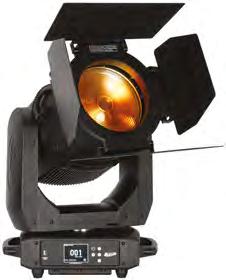













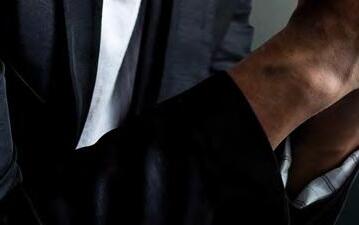










































SUITABLE FOR a variety of applications including projection mapping, Digital Projection has released the E-Vision 16000i WU boasting an upgraded electronics platform that shares much of its functionality from the TITAN series. Central to the new design is the implementation of Texas Instruments’ 0.8-inch High Efficiency Pixel (HEP) DMD, which allows for a higher brightness than was previously achievable on the 0.67-inch DMD, as well as colour and contrast. The updated DMD is optimised for solid state illumination, meaning that the brightness is at 16,000 ISO lumens. An increased tilt angle on the DMD mirrors allows for a wider colour gamut, helping to achieve “blacker blacks” by diverting light away more efficiently from the lens when the mirror is in the “off” position, giving an improved native contrast. The laser-phosphor projector is charged with ColorBoost + Red Laser technology to provide more realistic and saturated colours. In contrast, the E-Vision 10000i boasts 9,600 lumens of brightness and 20,000:1 dynamic contrast,
capabilities as the E-Vision 16000i. Digital Projection has also added to its Satellite MLS range with 20,000- and 30,000-lumen versions to complement the original 10,000-lumen light source, said to make installations easier than before by removing the need for “many-to-one” fibre configurations. The new fibres have a decreased diameter and higher light transmission efficiency so that when they’re coupled with the new light sources, they offer a large reduction in the system cost.
The manufacturer has also launched its Nexus “next-
which has been designed to deliver advanced image processing to all projectors including the Titan, M-Vision and E-Vision. The platform offers users the familiarity of its operation, OSD menu structure and functionality, all of which are integrated into the new Projector Control II software. Key features include enhanced multifunctional image processing technology, with de-interlacing, scaling, warping and edge-blending, all combined in a single IC, a built-in warp-table generator which implements realtime processing for horizontal and vertical keystone correction as
well as pincushion and barrel, wall corner correction and linearity correction. Alongside this, the platform can also accept dual input signals up to 4K UHD which are independently processed. Advanced onboard edge blending is said to work seamlessly with the Projector Controller II software, enabling multi-projector blends by way of high bit depth processing that provides a continuous image created from multiple projectors. HDR support comes as standard with support for SMPTE ST2084(PQ) and HLG. 10-bit colour processing (30 bits per pixel) produces 1,073,741,824 colours with seven-point colour correction for accurate colour matching which reportedly produces lifelike, saturated images. There is also full image quality control onboard with full-gamma colour management, allowing the implementation of key features such as constant brightness output, node-based fine-tuning of colour uniformity and multi-
AIMING TO expand its AV-over-IP workflow support, the free Dante AV 4K v1.1 firmware update from AJA Video Systems extends the capabilities of AJA’s Dante AV 4K-T and 4K-R transmitter/receiver converters. The update delivers support for HDR, ensuring HDR signals pass through the devices seamlessly and that users can easily change the HDR metadata on outputs received, and also introduces support for Ref In. This means that a device like the AJA GEN 10 HD/SD sync generator may be used to lock the output of the 4K-R when

sources. In addition, Dante AV 4K v1.1 activates a second locking Ethernet port (Eth2) on the device, allowing users to connect a second device to their Dante AV switch without needing to connect a second Ethernet cable directly to the switch.
DESIGNED TO support flexible auto-tracking of subjects over long distances, the triple lens VC-TR70 PTZ camera from Lumens auto-tracks at any distance between 2m and 30m. The company says it overcomes a limitation of most tracking systems which lose accuracy and reliability with distances beyond 8m. It features a 25x optical zoom, a pan/tilt mechanism and numerous mounting options to provide flexibility on camera installation. Built around a 1/2.5-inch UltraHD main camera sensor, the VC-TR70 has simultaneous SDI, HDMI, IP and USB outputs which means video can be incorporated into virtually any AV installation. As the camera supports Rec. 709 and BT2020 colour spaces, producers can easily match multiple units for use in live events and broadcast productions. Two additional face-tracking HD cameras are installed in the VC-TR70’s base to enable the AI processor to scan and analyse the scene, identify individuals
capabilities for the 4K-R let users scale 4K to UHD and downscale UHD to HD, with the ability to select between auto, native and crop 4K to UHD/Scale UHD to HD. The upgrade also validates select 4K and 8K 4x4 workflows where 4K-T signals can be

and follow a chosen subject. Switching between tracking targets is simple using either the supplied remote control or by tapping on the web interface. The PTZ is suited for use in larger venues where the camera is installed at a distance from the podium or presentation area.
www.mylumens.com
sent to four 4K-Rs and all four outputs are confirmed to be in time and in sync.
3G Level B
4:2:2
10-bit high frame rate is now supported, and compatibility with Audinate’s Dante Domain Manager can be purchased, enabling users to control Dante from touchpanels, as well as monitor status and automate workflows.
www.aja.com
TAKING THE guesswork out of prepping LED screens, ROE Visual has upgraded its ROE Calculator APP with a suite of tools that includes ballast calculation, pixel and resolution calculation, and power requirement analysis. Aiming to offer an all-inone solution for tackling calculations, it calculates data for LED technicians whether onsite or in the preparation stages of a production. Ballast calculation is simplified and requires just the wall size and stacking system information to calculate the
One controller to rule them all
THE VS-PTC-300 PTZ camera controller from Marshall Electronics provides the ability to mix and match cameras with different control protocols using just one controller, including NDI, RS-232/ RS-422/RS-485 and IP, VISCAover-IP and ONVIF. Providing user control across multiple cameras on a single network, the VS-PTC-300 can control up to seven RS-232 cameras, 14 RS-422 cameras and up to 255 NDI/IP cameras. It also allows easy NDI/IP setup utilising NDI/IP discovery setup functionality.
With 10 instant access camera control buttons, the VS-PTC-300 has a straightforward interface, and the information display screen doubles as a video monitor for NDI and RTSP streams. Featuring a PTZ joystick, professional zoom rocker and individual fine-tune adjustment knobs, the controller settings include iris, white balance, exposure, red/ blue, shutter speed, focus, pan/ tilt speed and zoom speed. The VS-PTC-300 can store up to six assignable function keys and

precise amount of ballast required to ensure optimal reliability for any LED screen setup. Meanwhile, the app also works out the required processing power and cabling setup for the resolution of a screen. It also provides accurate power consumption estimates to save both time and resources. The app is available for download from the App Store and Google Play, and is also accessible as a webapp.
www.roevisual.com

save up to 256 camera presets, while dedicated knobs and control buttons provide direct access to functions without needing to use on-camera menus. The built-in
display also allows the crew to easily check framing/focus, store presets and practise camera moves.
www.marshall-usa.com



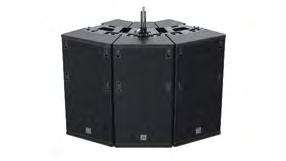

has released its ElectraPix Bar 8, a 0.5m linear LED wash fixture equipped with a wireless DMX transceiver and high-capacity internal rechargeable battery. Rated IP65, it can be used in any location with no wired connections and features eight individually controllable 20W hex colour LEDs (RGBAL+UV) paired with 32 background 0.2W RGB LEDs. The inclusion of a lime LED chip allows for an enhanced CRI and variable white colour temperature control of 2,700–9,900K. Meanwhile, the UV chip provides a “black light” effect and can also be combined with other chips to create colours like hot pink, deep purple and electric blue. It is supplied with an optional 20° diffusion filter and UCIR24 wireless remote. The ElectraPix Bar 16 offers the same feature set as the ElectraPix Bar 8 but in a larger 1m format with 16 20W hex colour LEDs alongside 66 background 0.2W RGB LEDs. Completing the ElectraPix Series, the ElectraPix Par 7 is a complementary LED PAR fixture and boasts seven main colour calibrated 20W hex LEDs paired with 29 background 0.2W RGB LEDs. It offers a concise 17° beam angle but is supplied as standard with a gel frame and 20° diffusion filter.


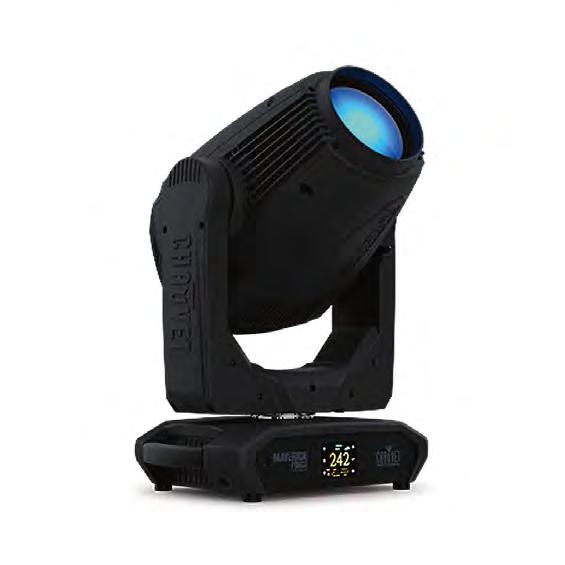
a frost. Housed in a compact and lightweight design and calibrated to match the colours of other Force fixtures in the rig, the Maverick Force 2 SoloWash comes with DMX,
panels
ADAM HALL Group’s lighting technology brand, Cameo, has added a range of fixtures across its AZOR and OTOS WASH series.
The AZOR SP2 and AZOR W2 have been designed for flexible use in medium-sized applications. The AZOR SP2 is based on a 300W LED light source with 13,000 lumens of luminous flux and a large zoom range of 5–50°. It is said to supplement the advantages of a classic spotlight with motorised framing blades (±60° rotatable) on four levels. The AZOR W2 combines seven individually controllable 40W RGBL LEDs and a zoom range of 4–50° for classic wash looks. Featured is the eclipse burst effect – behind a dark filter are four segment SMD LEDs, which create stroboscopic and pixel effects.
devices within a system transmit the DMX signal to one. In addition, the app can also be used to remotely configure compatible fixtures and provide basic DMX control. Expanding its range of professional LED video panel products, the WMS2 is ADJ’s highest resolution video panel to date. Designed to be integrated into a variety of applications, it can be mounted directly to a wall and has a front serviceable design. Its pixel pitch of 2.6mm results in a pixel density of 147,456/m² and its arrangement of RGB SMD1515 colour mixing LEDs generate a brightness of 800 nits. Crucially, a built-in Novastar A8s-N receiving card allows the WMS2 to be displayed horizontally or vertically, and the panel offers a wide viewing angle of 160° (horizontal) by 140° (vertical). In brief, ADJ has added the COB Cannon LP200. It shares the same LED engine and feature set as the COB Cannon LP200ST but in a longer enclosure.

The lighting manufacturer has also expanded the OTOS Series with three new models – the OTOS W12, OTOS W6 and OTOS W3. The OTOS WASH IP65 Wash moving heads are equipped with individually controllable RGBL LEDs and each has a separately controllable FX LED effects ring for the creative use of white tones and
colours. A notable feature of the OTOS WASH Series is the multi-zoom function. Depending on the model, up to three zoom levels can be controlled individually. The OTOS WASH Series also includes an integrated W-DMX and CRMX transceiver for the wireless transmission of DMX and RDM data.
THE HY B-EYE K15 Aqua is the latest member of the IP66 Shield family. Based on the manufacturer’s ALEDA B-EYE technology with


during transportation, extreme temperature fluctuations, impacts from hailstones, electrical stress, harsh surroundings and UV exposure. Meanwhile, the Rhapsodya is a highpower, low-noise, multi-spectral, LEDbased fixture designed for a variety of applications, including live events. It uses a custom 1,200W multicolour RGBAL LED engine, is capable of a 24,000-lumen output and features the Accuframe framing system using two focal planes for better resolution and focusing; Tonedown, which ensures operation at just 27dB; Absolute Position for advanced pan and tilt control; the Lineguard frost system using two pairs of blades for higher beam uniformity and incremental adjustment of frost levels; and ColorMatch calibration for matching colour temperatures to other fixtures when using Claypaky CloudIO software.
www.claypaky.it
GLP HAS introduced an upgrade to its JDC1 Hybrid Strobe. Larger than its predecessor, the JDC2 IP reportedly provides a significantly brighter output and is also IP65certified. The integrated beam line is equipped with 84 highperformance LEDs which are described as highly efficient at 10W each. The optimised, extremely steep flash ramps are said to ensure an even more realistic and intense strobe impression. With 12 individually controllable segments, the beam line offers extended intensity flash effects and more than 100 static and dynamic strobe patterns. The saturated colours
and brightness of the 1,728 LEDs are said to provide powerful diffuse lighting. This allows stages and spaces to be completely immersed in colour. A rich colour environment is created, especially when combined with haze. The specialised black LED masking ensures a black front appearance, while eliminating reflection from other light sources.
The manufacturer has also extended its FUSION X-PAR range with the addition of the FUSION X-PAR 8Z, which rounds off its series of weatherproof LED PARs with motorised zoom up and down. Described by GLP as a real
WITH A compact footprint, punchy output and a professional feature set, High End Systems’ Ministar is an automated lighting fixture designed for small and medium-sized venues. It boasts two ETC innovations: firstly, its dual colour wheels create what ETC calls VersaColor technology to provide a spectrum of 60 pure colours that are accessible via a single channel. Secondly, complementing VersaColor,

ETC has announced that F-Drivecompatible versions of the Irideon FPZ, Irideon WLZ and Source Four Mini LED are now available to help make it easier for users to pair ETC luminaires with the company’s flagship LED driver solution. According to ETC, direct connection to the F-Drive system enables facilities to build more cost-effective lighting systems. The F-Drive LED power system is both modular and centralised for “easy installation and maintenance”. Swappable driver cards and power supplies in the F-Drive R12 rack are
said to make all critical components readily accessible. A wide variety of LED systems, including Irideon and Source Four Mini LED, can take advantage of the centralised drive and power structure of F-Drive to reduce costs and simplify the remote lighting positions. Source Four Mini for F-Drive offers a compact LED solution that reportedly fits seamlessly into any lighting system, while Irideon FPZ for F-Drive and Irideon WLZ for F-Drive are said to bring a “sleek design” to any F-Drive system.
www.etcconnect.com

X-PAR 8Z is the most compact and lightest in the series. At 4.5kg, it has been designed for applications with limited space. The 8Z comes with an 80W RGBL LED and emits up to 1,800 lumens thanks to GLP’s patented iQ.Gamut colour calibration. The compact housing (175mm x 175mm x 249mm) allows it to be used in a variety of applications, and the 132mm Fresnel lens reportedly ensures an excellent light image. Thanks to the motorised zoom, powerful 8° beams are just as possible as
QuadraTech harnesses the power of four colours within the projection to create visual effects in washes and aerials.
The Ministar uses a 300W custom LED to generate an output exceeding 9,700 lumens. Its feature package includes dual pattern wheels for gobo morphing and textural manipulation, variable frost for softening edges and washes, and a prism to elevate theatrical applications and

create aerial effects. The Ministar has swift pan and tilt functionality for dynamic movements, while its 6.5–48° zoom function is housed within a lightweight and compact 16.2kg design.
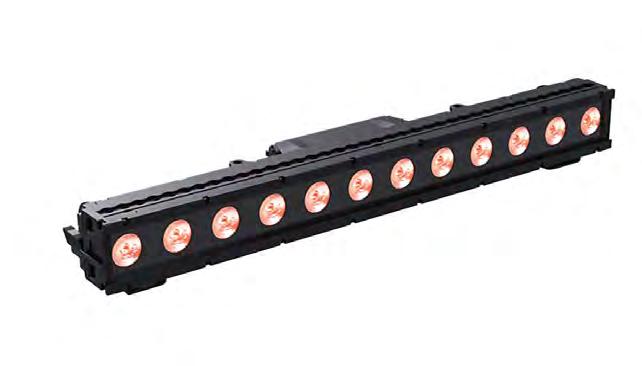
output, a wider colour spectrum and an overall higher quality of light. Available with either seven or 14 20W RGBLA+UV LEDs, the Six+ Par offers a homogenised wash of light with improved colour rendering capabilities. Expanded control capabilities are said to make for a more versatile luminaire and its robust IP65 housing can “handle any environment”.
The Six+ Bar forms part of a range of LED batten solutions that combine the latest LED colour technology with an IP65 design. An upgrade of the manufacturer’s SixBar, the Six+ Bar is equipped with 20W RGBLA+UV LEDs and boasts a CRI of 93, increased output and a broader colour spectrum.
Inspired by the radiant sun, the Sōl I Blinder is the first in a series of creative LED blinder and effects
configuration and arrangement. The blinder can be used as a single-, twoor four-cell blinder or be connected with other fixtures for eye-candy looks. It can also be used to create linear blinder arrays, single or multiunit pendants and custom shapes. Finally, the Pulse Bar is the first
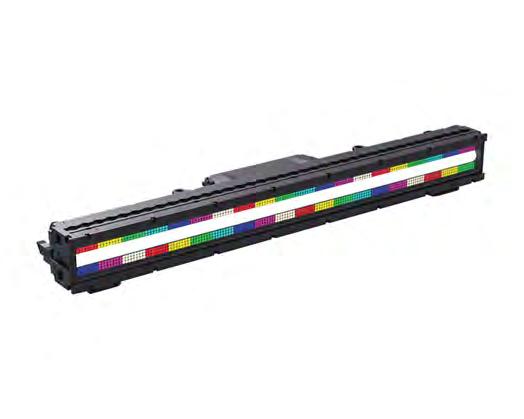
www.elationlighting.eu
THE NEUTRIK Group’s Contrik brand has expanded its CKPE series of power multicore cable assemblies with the Harting E16 and Socapex SL 419 compatible Power Multicore connection cables, and the Socapex SL 419 compatible single-phase powerCON TRUE1 Power Multicore Split cable assemblies. Specified for use in videowall, lighting and audio applications, the rewireable power multicore cable assemblies complement Contrik’s portable power distribution systems and are DIN 15765 standard-compliant for mobile event production.
The expanded Power Multicore cable range offers six- and eight-channel Harting E16 connector variants, and a six-channel LKS 19 (Socapex SL 419 compatible) connector variant, while the


Power Multicore Split cable features an LKS 19 male to 6x single-phase powerCON TRUE1 female connectors. The company claims the cables’ increased PE-conductor cross-section improves reliability which extends to operation across a range of –5°C to +70°C, and all offer high IP protection ratings in mated condition.
www.contrik.com

launch of additional components. The introduction of a two-channel Dante receiver, a network charger with cascading and an active directional wall-mounted antenna provide additional hardware options, while Sennheiser’s Control Cockpit, Wireless Systems Manager and Smart Assist App software have been updated to include support for the EW-DX components. Adding to its non-Dante two-channel receiver, Sennheiser now offers the EW-DX EM 2 Dante, a half-rack (9.5-inch) two-channel receiver that allows for various network modes to integrate into existing workflows. The receivers have a switching bandwidth of up to 88MHz, which can translate to up to 146 channels in standard mode and up to 293 in link density mode. In addition, the CHG 70N-C replaces the CHG 70 noncascading variant of the EW-DX
network charger units. Finally, the AWM wall-mount antenna is

microphone systems. It can be connected to any stationary Evolution Wireless Digital receiver or EW-D ASA antenna splitter and is available in three product variants: AWM UHF I (470–694MHz), AWM UHF II (823–1,075MHz) and AWM 1G8 (1,785–1,805MHz).
www.sennheiser.com
TASCAM HAS released a pair of closed-back headphones, with the aim of “combining quality sound with affordability”. The TH-11’s sensitivity and frequency response are said to ensure balanced sound suitable for many music genres and applications and reportedly provide clear highs, a well-defined midrange and a robust low end. Because a clean, modern look and comfort are just as important as the sound, the TH-11 features plush cushioned ear cuffs and a padded headband for long hours of comfortable use. The headphones also offer flexibility with 90° rotation on both sides, making them suitable for extended use. The folding design allows for easy portability wherever they need to be taken.

Additionally, the Japanese brand has added a second-generation professional Blu-ray player. The BD-MP1MKII is a 1U rack-mountable player that supports a wide range of media formats via Blu-ray, DVD and CD discs together with videos, still images and audio
512 gigabytes (SDXC). A poweron play function enables playback
powering up. Combined with repeat playback, the audio/video content will start, loop and play continuously until the system power is turned off. The repeat function can be defined by chapter, title or A–B range. Avoiding visual distractions during operation, the BD-MP1MKII displays a black screen on the monitor during startup and hides status messages. Outputs

capture 32 channels directly to an SDXC card. In regions other than the US, the optional IF-MTR32 can easily be installed into one of the two open expansion slots to enable 32-channel multi-track recording. The
with 44 input channels (40 mono channels and two stereo channels), 22 flex output busses and the L-R main bus with 31-band graphic EQ.
www.tascam.jp

US LOUDSPEAKER manufacturer
1 SOUND has announced the introduction of its Auralis 3D audio design and prediction software. Auralis is a multipurpose sound design tool that enables precise, high-resolution, full-colour audio predictions for any loudspeaker design in a three-dimensional space. It can import 27 different types of files, including SketchUp
(SKP) and AutoCAD (DXF) files, as well as creating its own threedimensional spaces using fingertipfree rotation and named groups.
1 SOUND says Auralis can quickly create a line array using 1 SOUND’s Tower Series, for example, and automatically splay for uniform coverage to provide a quick and accurate place to plan for system optimisation. From there, users
D&B AUDIOTECHNIK has unveiled key Milan-enabled audio solutions, including the DS100M signal engine and the D90 power amplifier. The DS100M is the Milan-enabled iteration of the DS100 with Dante. Leveraging the technological power of Milan, the DS100M extends its functionality to provide an expanded range of features. These include more audio channels via Milan, MADI and word clock inputs,
maintains lower internal temperatures at the highest output to promote long and reliable operation. By incorporating Milan networking technology, its design allows seamless configuration for redundant system setups for audio signal transport, complemented by fallback capabilities for all inputs and device communication. d&b has also announced the launch of En-Bridge, a software

sound quality and performance, increased system efficiency and powersaving features. As well as providing maximum loudspeaker performance, it
available for Windows and macOS that provides OSC bridging and thirdparty protocol translation for remote control of Soundscape parameters
FULCRUM ACOUSTIC has introduced Fulcrum One, a system design and simulation software available for Windows and Mac. The system streamlines the design, deployment and management of both traditional sound reinforcement and immersive audio systems within a single, user-friendly interface. The allin-one nature of Fulcrum One “saves time, reduces the need for multiple software applications and caters to the needs of diverse audio projects”. Incorporating the Fulcrum Acoustic loudspeaker catalogue, Fulcrum One enables users to accurately plan and position loudspeakers within a 3D venue model. The software will also facilitate
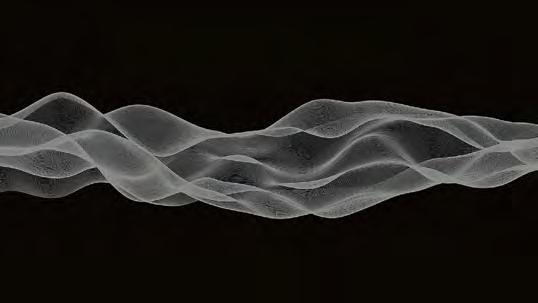
can see 3D acoustical mapping, SPL predictions and measure phase coherency and off-axis response. The application works with all 1 SOUND loudspeakers and rigging hardware with measurement
on the DS100 signal engine. It allows BlackTrax tracking systems to be used for automatic object positioning on a Soundscape system, including the latest BT-1 system, by translating the BlackTrax RTTrPM protocol into DS100 OSC commands and providing additional mapping functionality. Meanwhile, En-Snap, the d&b Soundscape cue automation and show control software provided in collaboration with d&b and Gareth Owen Sound, has been given a major upgrade and is now available to all Soundscape users as En-Snap V3. In addition to a range of new cue automation features and show control workflow improvements, the update adds the ability to use En-Snap as a standalone sound object control user interface for FOH for all types of immersive live stage performances using a d&b Soundscape system. The Object Viewer allows users to monitor and control the positions of sound objects directly in En-Snap, within a workflow that supports positioning and parameter editing for a single object or group selections in
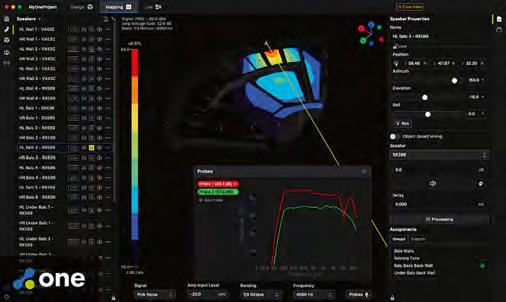
the creative design of active acoustics and object-based mixing
microphones, and is able to generate customisable reports with design photos, notes and other relevant information for reporting.
www.1-sound.com
absolute and relative editing modes. The ability to organise the visibility of objects, background images and view sections in user-defined “view presets”, combined with options to colour objects and assign names, reportedly ensures maximum customisation. Input groups for quickly selecting multiple objects for mass editing and object linking with multiple mirror modes for group positioning provide efficiency within the streamlined, user-centric workflow of the Object Viewer, which has been designed for object-based content creation in immersive live applications. En-Snap supports single and multiple DS100 setups and is available for macOS and Windows. En-Snap V3 is a multi-window application with separate windows for Cue automation and Object Viewer and also provides compatibility with V1 licences and show files. To take advantage of En-Snap V3’s many features, the software must be connected to a DS100 signal engine.
www.dbaudio.com
components for immersive audio installations powered by the Fulcrum Immersive Venueflex processor.
A key feature of Fulcrum One is its acoustic simulation capability, which allows users to accurately predict how their sound system designs will perform in real-life settings. Its rapid processing power enables near realtime calculations for loudspeaker coverage mapping and maximum SPL visualisation. Fulcrum One also offers advanced optimisation for line array configurations, signal processing and system equalisation.
www.fulcrum-acoustic.com




17 - 19 April 2024
China National Convention Center (CNCC) Beijing, China www.infocomm-china.com
17 - 19 July 2024
Queen Sirikit National Convention Centre (QSNCC) Bangkok, Thailand www.infocomm-asia.com
For sales enquiry: aliciachen@infocommasia.com For visitor and media enquiry: angieeng@infocommasia.com
3 - 5 September 2024
Jio World Convention Centre (JWCC) Mumbai, India www.infocomm-india.com
US WIRELESS audio specialist Lectrosonics is keeping legacy users in the loop with its SRDB25AES Digital Output Adapter for SR Series receivers. The adapter converts receiver analogue audio outputs to AES digital at 48kHz, enabling users to mount older and newer receivers together in various docks, all with digital audio connections. Aiming to provide more options for users with a variety of hardware platforms, the SRDB25AES mounts onto any Lectrosonics Digital Hybrid Wireless SR Series two-channel slot receiver. The company says it is especially useful when pairing an older unit like an SRC in a slot dock with a new receiver like a DSR4, allowing all channels from both receivers to enter through the slot in a common digital format. The adaptor is also suitable for SRB and older SR receivers while no data connection is present, so receiver settings need to be made via the receiver front panels. However, the SRC does have a data connection, and all previous functions are retained

in terms of receiver control through the slot interface. SRB receivers with the FM01 update also have this data connection. While the height is identical, this adapter adds around 1⁄2 -inch to the receiver case length, which means that any slot-mounting hardware used for the DSR4 can be used with an SR receiver and the SRDB25AES bottom plate. The manufacturer has also released its BAGFRAME organisers, designed

audio applications, Lawo has upgraded the mc²36 audio production console. The mc²36 MkII integrates A__UHD Core functionality offering 256 processing channels, available at both 48kHz and 96kHz, and natively supports ST 2110, AES67, RAVENNA and Ember+. With an I/O capacity of 864 channels available, local connections include three redundant IP network interfaces, 16 mic/line inputs, 16 line outputs, eight AES3
User-centric features include Button-Glow and touch-sensitive rotary controls, colour TFT fader-strip displays, LiveView video thumbnails and precise 21.5-inch Full HD touchscreen controls. Featuring peak and loudness metering for measuring individual channels as well as summing busses, the built-in full loudness control is compliant with the ITU 1770 (EBU/ R128 or ATSC/A85) standard.
www.lawo.com
to mount portable receivers via specialised accessory kits, and keep these receivers organised in a bag. The BAGFRAME units are available in several different widths and heights to accommodate a variety of receivers. Two different BAGFRAME widths are available – one for two receivers and one for three receivers – while three different heights are available: S (short), M (medium) and T (tall). The units are
shipped ready to be assembled and are constructed of aluminium alloy, making them sturdy and tough and yet also lightweight. The BAGFRAME units use snap-in inserts for all receiver mounting. Some receivers also require screws and mid-frame mounts. Audio and data connections are all handled per receiver, via whatever audio outputs or backplates are used on those receivers.
The TM400 test and measurement system eliminates the need for long cable runs between hardware or software test platforms (such as SIM, SMAART or TEF) and a calibrated measurement microphone. An HMa or DPR-A plug-on transmitter snaps directly into the XLR barrel of the mic with no need for cabling, and the R400a or DSQD receiver provides digital signal handling for audio free of companding artefacts. The TM400 has a wide dynamic range and flat frequency response, delivering the accuracy and low latency of a cable “with none of the hassle”.
www.lectrosonics.com
DESCRIBED AS a significant upgrade to the company’s current RF system, the RF 865/915 series is said to offer improved sound quality, extended transmission range, inbound Bluetooth streaming, a handheld RF transmitter and a software suite that can be used for fast group programming via smart chargers.
output drivers, while the V15a+ is a dual output option with integral phase shifter for phased array configuration. Building on features

RF range
The ID-7 is a low-profile loop driver that offers a number of integrated variations with features such as battery backup, AGC and Class-D electronics. This range is designed to deliver clarity of sound to hearing aid users in small spaces. Meanwhile, the manufacturer has also upgraded its V Plus hearing loop drivers. Designed for small and medium-sized venues, the V7+ and V15+ are constant current single

from the current V Series range, the upgraded units add enhanced loop diagnostics and switchable AGC (on/off) which, together with the Class-D output stages, reportedly allow the V+ drivers to achieve “first-class” sound reproduction. Additional features include adjustable acoustic time delay, high pass filter and continuous self-testing.
www.contacta.co.uk



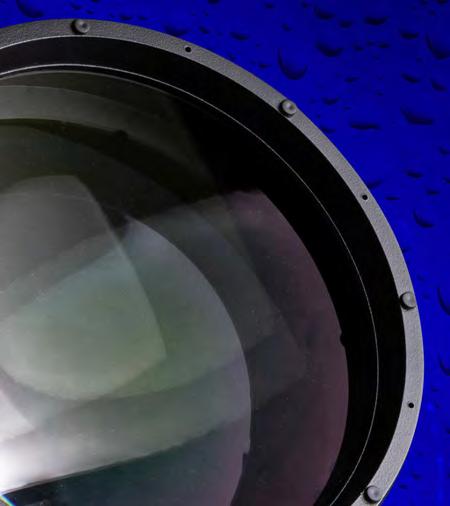




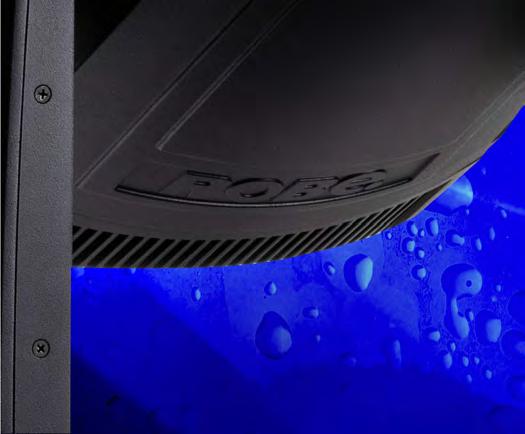


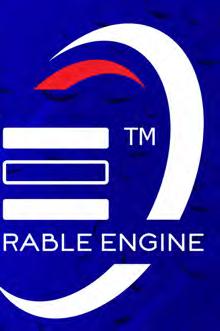





BLAZE AUDIO has released four PowerZone Connect eight-channel amplifiers. The PowerZone Connect 508, 1008, 4008 and 6008 are powered by Pascal UMAC Class-D technology and are available in 1U (PowerZone Connect 508/1008) and 2U (PowerZone Connect 4008/6008) form factors.
The amplifiers can power both conventional low-impedance (508 and 1008: 4–16Ω/4008 and 6008: 2–16Ω) loudspeakers and constant voltage (70V/100V)
transformer-coupled loudspeakers. They also feature automatic powersharing technology for proportional distribution in both Lo-Z and Hi-Z modes. All models also incorporate Blaze Audio’s DSP web app controller, PowerZone Control, for an “intuitive” system setup.
The total power of all four models ranges from 500W to 6,000W, with the PowerZone Connect 4008 and 6008 exceeding 3,000W, making these two amplifiers the first Blaze Audio models to
reach this power rating. They all offer eight balanced Euroblock inputs and eight unbalanced RCA Phono inputs. They also include S/PDIF digital audio I/O with routing that can be configured via the PowerZone Control web app, a configurable GPIO (General Purpose I/O), along with eight configurable loudspeaker outputs that use Euroblock connectors. The manufacturer has also announced that its PowerZone Connect amplifier series units are

a gateway device designed to connect all of its current products to its MyUniverso cloud platform. The Verso gateway helps systems integrators and IT managers take full advantage of the MyUniverso cloud platform.
Formerly known as Universo, MyUniverso has now merged into MyPowersoft, ensuring that all users with MyPowersoft accounts can access the cloud platform. Verso is a half-rack width device designed to enable access to the
MyUniverso cloud platform and all its related functionalities for the entire current Powersoft amplifier portfolio, allowing monitoring and centralised remote firmware updates for all connected amplifiers, as well as supporting Powersoft’s Dynamic Music Distribution (DMD) solution. Verso’s logging and data storage capabilities reportedly ensure local continuity or service, even during internet outages. It also incorporates the Easy Swap procedure, introduced as part of Unica’s features last year, making it “simple and convenient” to address any service outage swiftly, in the rare event of a malfunction. The gateway device is compatible with
now available as Dante-equipped models. Dante AoIP compatibility caters to the demands of networked audio systems requiring up to 4x4 channels at a sample rate of 44.1kHz and 48kHz. Launched in 2022, the four PowerZone Connect models currently include the 122D (125W/two-channel), 504D (500W/four-channel), 2004D (2,000W/four-channel) and 3004D (3,000W/four-channel) amplifiers.
www.blaze-audio.com
third-party cloud platforms, providing users access to baseline cloud project backend information. Additionally, through Verso it is possible to access MyUniverso’s remote firmware update functionality, minimising the need for repeated trips to installation sites. In other news, the manufacturer’s Unica Series now benefits from the addition of DMD functionalities, previously exclusive only to Mezzo. With the launch of the lower-power Unica 1K8 and Unica 5K4 models and the addition of DMD features, Powersoft is boosting the “one-sizefits-all” nature of the Unica platform.
www.powersoft.com
DIGIKVM FROM ATEN International is a range of all-digital KVM-overIP OmniBus Gateways and KVM DigiProcessors designed to advance IT/OT convergence. Claiming virtual media data transfer rates up to 10 times faster than typical KVM-overIP switches, ATEN’s KG0016 and KG0032 are universal KVM-over-IP OmniBus Gateways. Engineered to facilitate digital transformations in server rooms, control rooms and broadcasting applications, they offer centralised control through a single, secure access point, enabling immediate BIOS-level access to all connected servers. OmniBus Gateways offer robust security through an all-digital KVMover-IP infrastructure and feature
Java-free remote access via HTML5
WebClient or advanced WinClient options. TLS 1.3 and FIPS 140-2 certified OpenSSL cryptographics enhance security, while compatibility with DP, DVI, HDMI and VGA ensures versatile server connectivity. The OmniBus Gateway allows up to 32 remote users to access servers in real time. Server connections can be extended up to 100m and remote
access to all servers is available wherever users are located. Visuals from a specific server can be displayed at 1920x1200 @ 60Hz, while video feeds from all servers are organised in a multi-view grid layout to ensure real-time monitoring for situational awareness. During emergencies, the KVM-over-IP OmniBus Gateway also allows IT operators access via out-of-band management.
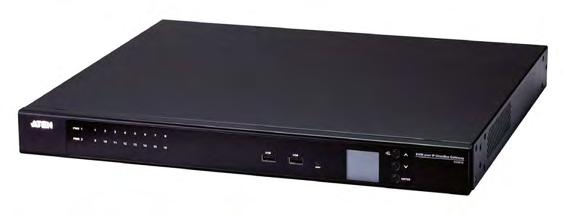
ATEN has also released its CM1942 two-port 4K DisplayPort, dual display mini-matrix KVM switch.
Designed to offer instant access to two DisplayPort computers and two USB 3.1 Gen 1 peripherals from a single USB/HDMI console, it supports two operation modes: single PC mode and dual PC mode, offering full content display flexibility. It features boundless switching for easy cursor movement between screens and an audio mixer mode for mixed audio output from both computers. The CM1942 supports flexible port switching options, including pushbuttons, hotkeys, mouse and the remote port selector.
www.aten.com
SOUND DEVICES has announced the launch of the Astral Wireless Guitar System, a high-performance implementation of the company’s Astral-series wireless product ecosystem designed specifically for guitar and bass players. The A20-TX Smart Guitar Cable and A20-TX Guitar Strap Clip work together with Sound Devices’ A20-Nexus True-Diversity wireless receivers and A20-TX transmitters “to provide the sonic purity, signal strength and operating range for a no-compromise wireless experience in any venue”. The patent-pending A20-TX Smart Guitar Cable is at the core of the Astral Wireless Guitar System and uses circuitry within the ¼-inch plug to allow for user-adjustable capacitance and impedance to make sure that the guitar’s pickups interact the same way with the wireless transmitter as they would hard-wired. This keeps the exact sonic character and “feel” of the guitar and amp interaction as compared to any other wireless
series products, the Wireless Guitar System also benefits from Sound Devices’ proprietary SpectraBand technology that boasts a global tuning range of 169–1,525MHz for compatibility and use anywhere in the world while on tour.

DESIGNED FOR a wider audience, PK Sound has developed the T8 sub-compact robotically controlled line source. Featuring PK’s patented multi-axis robotics, the T8 can attain a peak SPL of 143.5dB down to 400Hz in the vertical and horizontal planes. Designed for pairing with the T18 intelligent subwoofer, PK Cell modular touring rack and PK.dynamics control software, the T8 system incorporates inclinometers and network-based Auto-Array via .dynamics software. Enhancing the speed, safety and accuracy of any deployment, each T8 module can recognise its position and angle within the system. Robotic control, onboard DSP and network data are routed through IP65-rated connectors on the rear panel. The three-way T8 enclosure comprises dual vented 8-inch Tetracoil transducers with custom phase plugs and a coaxial compression driver in addition to a two-channel VE15

K-ARRAY HAS unveiled four product additions to its K-array, KGEAR and KSCAPE brands. Joining the K-array catalogue is Prisma, a digital matrix and amplifier series designed for applications that require advanced signal routing and processing capabilities. The KGEAR brand, meanwhile, has unveiled the GU210 subwoofer and GMX4L mixer, and KSCAPE a more compact variant of its Rail integrated lighting and audio system. The Prisma digital matrix and amplifier series has been designed for applications that require advanced signal routing and processing capabilities.
Powered by K-array’s operating system OsKar, Prisma can handle up to 16 inputs and 16 outputs (analogue and Dante) and has been designed to provide a complete K-array solution for a wide range of settings.

frequency control from 400Hz–20kHz reportedly results in significant SPL reductions between on- and off-axis coverage points, according to the Canadian manufacturer. Flown straight, the array’s directivity is configured remotely using industrial linear actuators, with vertical angles variable in 0.1° increments. A combination of FIR and IIR filters can also be applied to ensure
throughout the listening area. The T8’s elongated waveguide is robotically manipulated to offer variable symmetric and asymmetric horizontal dispersion in 49 configurations, from 60–120°. Enabling the configuration of tapered arrays for unique coverage requirements, the array’s radial directivity can be shaped remotely in real time. Indoor venues benefit
Moving to KGEAR, the release of the GU210 subwoofer fills a gap in the line-up for a 10-inch lowerfrequency cabinet. Available in both a black and white finish and with an IP64 rating that makes it suitable for outdoor use, the GU210 is said to be ideal for discreet placement. The GMX4L mixer is an expansion of KGEAR’s GM44L matrix and boasts user-friendly controls and accessible advanced options. The GMX4L is said to integrate seamlessly with KGEAR’s amplifiers and the GM44L matrix. Lastly, KSCAPE Rail S is a more compact 1.2m version of the product and comprises Lyzard KZ1 loudspeakers along with CASAMBIcontrolled lighting. While it offers a different audio experience to traditional Rail products, it is also reportedly more versatile and scalable in comparison.
www.k-array.com
from the energy being focused on the audience away from reflective surfaces in indoor venues and outdoor applications can mitigate noise pollution emissions to the surrounding residential areas.
The low-profile T18 subwoofer offers peak SPLs of 140.4dB within an operating range of 25–100Hz. Sharing many internal components with PK Sound’s T218 subwoofer, the T18 features a front-loaded, long-excursion 18-inch transducer in a bass-reflex design. A large, unrestricted vent enables high SPL performance with minimal port distortion. A single, field-replaceable module on the rear of the cabinet contains the 2,700W Class-D amplifier, control electronics and power supply. DSP and Milanready networking are included for ease of setup and calibration.
www.pksound.live


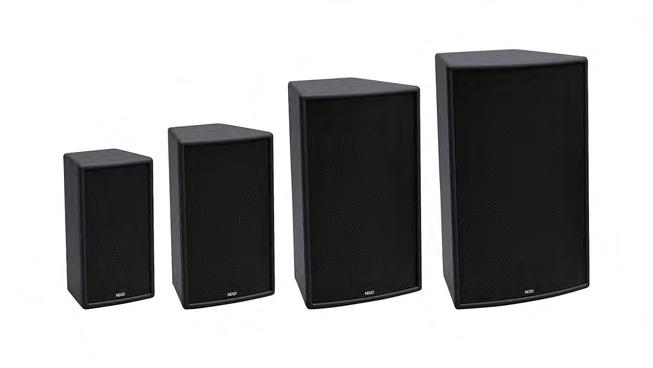
vertical positions. NEXO’s NXAMPMK2 powered controllers include presets for ePS Outdoor to make it easy to include components

needs. The system’s Autolock rigging system is said to allow a single technician to quickly and safely set up an entire system, saving time and labour costs.
The VGt element is part of an ecosystem designed to work with Adamson’s Array Intelligence software that includes brackets, dollies, accessories and covers. Array Intelligence allows
for the combination of the VGt with the CS-Series, while the Adamson Bridge closes the gap to integrate all legacy ground-amplified systems.
The Optimisation feature ensures broadband coverage correction without adding any latency.
Light weight is another attribute of the VGt, with an array of 18 VGt requiring four rack units, and only six power and network homeruns.
www.adamsonsystems.com
ELECTRO-VOICE HAS launched the EVERSE 12, which the manufacturer claims to be a “larger and louder” 12-inch two-way option for users looking for bigger sound than the EVERSE 8 – although maintaining the battery performance and wireless-friendly features of its 8-inch counterpart. The larger model boasts a maximum SPL rating of 126dB, a low-frequency response reaching 45Hz and 100° x 60° coverage.
Said to be suitable for an array of scenarios, the speaker caters for both inside and out. The EVERSE 12’s custom-designed Li-ion battery pack is optimised for audio use and said to provide power for over 12 hours at an average SPL of 100dB with typical programme material or over six hours at the maximum output level before limit indication, surpassing the EVERSE 8’s equivalent performance at 95dB.
The components are powered by a Dynacord high-efficiency
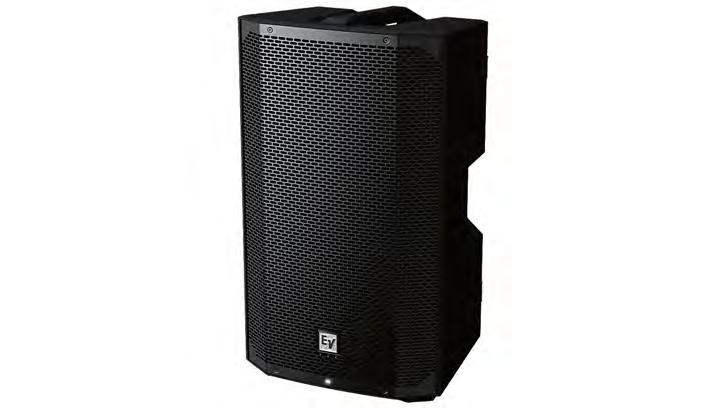
The EVERSE 12 is equipped with an array of new features including a weatherised design, a titanium-diaphragm compression driver and true wireless stereo
streaming and app control/mixing. Its woofer and titanium-diaphragm compression driver are coupled to a patented SST ported waveguide, resulting in a significantly smaller enclosure. The app allows pairing and grouping of up to six Bluetoothequipped Electro-Voice portable loudspeakers, in any combination.
DSP module. Features include
mixer with studio-quality effects and processing, mode/location/ subwoofer presets, 48V phantom power, feedback suppression and audio ducking. Local configuration
single-knob encoder with LCD. An integrated 12V DC port draws battery, making it suitable for wireless microphone systems.
soft-touch handle and lightweight construction aim to simplify moving and mounting, whether it’s onto a tripod for an extended throw, set long-side-down as a stage wedge with a 55° monitor angle or placed upright with a 25° kick-back angle. An optional rain cover, as well as a duffel bag, are available for additional weather resistance.
www.electrovoice.com
CONCEIVED AS a complete PA solution for medium-throw sound reinforcement scenarios, Audiofocus has unveiled its ARRoCC constant curvature loudspeaker series. The ARRoCC system comprises the wide-coverage CC210W cabinet and its narrow coverage twin, the CC210N, plus the 118S compact subwoofer. The CC210W and CC210N each house a pair of V-mounted 10-inch LF transducers with Tetracoil double voice coils. A 4-inch titanium diaphragm HF compression driver allows Audiofocus to employ a lower crosspoint, resulting in better dispersion and control down to the
lower frequencies. Both cabinets achieve a peak SPL of 135dB and a frequency response of 55Hz–19kHz.
The CC210W and CC210N offer 25° x 90° and 12.5° x 90° coverage respectively, and can be deployed either vertically or horizontally according to the needs of the event. ARRoCC is the first system to incorporate Audiofocus’s 3D printed Severin precision waveguide for rigid definition of coverage patterns, which the company says ensures an optimal listening experience for all audience
The 118S compact 18-inch subwoofer has been specially developed to complement the ARRoCC series and rigging system and has a frequency range of 30–100Hz with a peak SPL of 135dB. Supported by a comprehensive system of accessories allowing it to be stacked or flown in numerous configurations, ARRoCC loudspeakers are offered in self-powered and passive versions. Multiple self-powered cabinets can be managed remotely from any device via Audiofocus’s

DESIGNED FOR acoustically challenging environments, the CA 163 from Extron is an easyto-mount column array speaker which features a focused vertical dispersion that directs sound to listeners instead of reflective ceilings or floors. Providing a contemporary aesthetic, it is available in paintable black or white. Designed for one person to mount securely, the speaker uses two mounting systems to accommodate different room layouts and sizes. The company includes a wall-mounting template to make it easy to accurately position – once the mounts are installed, a slot on the rear of the speaker allows it to slide up and down to the desired height. The CA 163 PT includes a pan and tilt mount for maximum speaker aiming flexibility, while the CA 163 LP includes a low-profile mount for minimal protrusion from the wall.
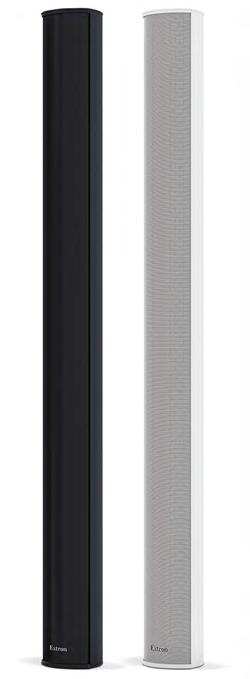
www.extron.com

Get broadcast quality H.264, ProRes and DNx files recorded to SD cards or SSD media!
HyperDeck Studio lets you record broadcast quality video files directly onto SD cards and SSD media! The new redesigned HyperDeck Studios feature modern design with more codecs and quieter cooling. All models now support recording to H.264, Apple ProRes or DNxHD files with either PCM or AAC audio. For ISO recording, there’s even built in timecode and reference generators for syncing multiple units!
The new HyperDeck Studio models have been totally redesigned with dozens of new features! The Pro models feature a machined metal search dial with increased mass and a soft rubber surface that feels nice to the touch. Plus the search dial features an active clutch, just like a traditional broadcast deck! With dual media slots, you can change cards without interrupting recording!
If recording to other types of media is required, the USB-C expansion port lets you plug in an external flash disk for recording. USB-C flash disks have unlimited capacity because they can be physically larger than an SD card or SSD. Just move the disk over to a computer and instantly start editing! There are also menus for managing external disks on the built in LCD.
HyperDeck supports the most popular codecs in use today! All models include DNx and ProRes file formats. However all models also include H.264 in quality up to 10 bit 4:2:2 when recording in NTSC, PAL, 720p, 1080p and true 1080i interlaced formats. While the 4K model adds H.265 when recording in Ultra HD. The Plus and Pro models have ProRes 4444 for fill and key playback!
Depending on the model HyperDeck Studio features a wide range of video and audio connections such as 3G-SDI, 6G-SDI or 12G-SDI. All models include HDMI for connecting to televisions and projectors. There’s even a dedicated SDI monitoring output on the Pro and Plus models with on screen status. The 4K model has 10G Ethernet for extremely fast network file copying!
ADDING TO the MAUI G3 Series launched last year, LD Systems has unveiled the MAUI 11 and 28 G3 MIX models. Providing an integrated six-channel digital mixer, numerous professional-quality built-in effects and convenient wireless remote control via mobile phone or tablet, the additions have been designed
for performers who don’t want to bring a separate mixer to gigs, such as singer-songwriters. The manufacturer has also released QUESTRA v1.2, which includes a number of significant updates designed to improve functionality and enhance the user experience, such as improved system architecture

PROMISING TO deliver extended with five new loudspeakers ranging models offer wide, symmetrical coverage in a compact enclosure, making them suitable for applications where they are closer to the listener and/or controlled coverage is not required. The series includes the PL-CA5, PL-CA6, PL-CA8, PL-CA12 and PL-CA15. Pairing them with Q-SYS network amplifiers is said to offer several benefits, from custom loudspeaker voicings and protection safeguards to advanced telemetry, helping to speed up deployment and deliver an optimal system operation experience.

www.qsys.com
RCF HAS unveiled MK5 models for its ART 7 Series. Features include 132dB max SPL, 1,400W two-way peak power, DSP processing, a 3-inch titanium compression driver, a 15-inch neodymium woofer, an 800Hz crossover point and a 90° x 60° wide dispersion constant directivity horn. The ART 708-A MK5, ART 710-A MK5, ART 712-A MK5 and ART 715-A MK5 models feature new compression drivers with Kapton diaphragms for increased definition, strength and thermal resistance, while the ART 932-A MK5, ART 935-A MK5 and ART 945-A MK5 feature pure titanium compression drivers and neodymium magnets. The new 1.75-inch voice coil in all models has been designed to reduce distortions and improve robustness, while the constant directivity waveguide provides “perfect” coverage to the listening area and continuity with the woofer emission. Newly tuned presets and settings are said to take full advantage of the XBOOST algorithm for optimal sound at any volume.
and an expanded device library. Another new feature is Scenes, which provides global automation of actions involving all devices in a project. Other developments include an Elements Library, Widgets, Multiselection in pre-edit mode plus direct software upload for QTP touchpanels, which are all said to contribute to an improved user experience.
www.ld-systems.com
WHARFEDALE PRO has announced the launch of two product ranges: the WLA-210XP line array system and T-Sub active subwoofers. The WLA-210XP is a dual 10-inch passive array featuring the manufacturer’s
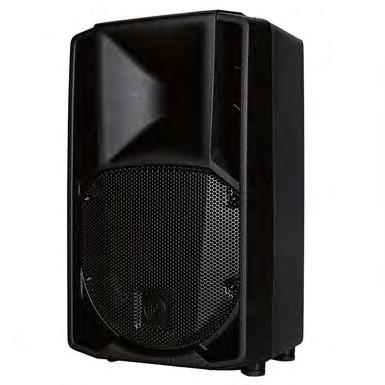
The Precision Transducers Series has expanded with seven additions, including the NDT895 and NDT995 titanium/neodymium compression drivers, and the NDX595 and NX495 1.75-inch PKX dome compression drivers. Recently released cone drivers include the LN19S400 and LN19S450 subwoofers, featuring 19-inch high-power voice coils, and the 16-inch LN16S400 woofer, offering improved bass reproduction and high excursion capabilities. The transducers feature ultra-long excursion and four-layer ultra-light CCAW voice coils.
The Italian manufacturer has also extended its NXL active column speaker series with the NXL 14-A. Available in black and white, the self-powered NXL 14-A boasts two 6-inch woofers, a 1.75-inch PKX HF driver and a 2,100W amplifier. Newly released are also the S 8019 single and S 8029 double 19-inch subwoofers that come equipped with high-excursion transducers and have been designed to be paired with the XPS 16K amplifier.
Finally, the SUB AX Series offers full DSP control and Bluetooth remote capabilities. The SUB 15-AX and SUB 18-AX models centralise loudspeaker management on the subwoofer with professional digital tools for tuning and optimisation. MK3 versions of the SUB 8003-AS and SUB 905-AS subwoofers have been updated with improved sound quality and a new polyurea coating.
www.rcf.it
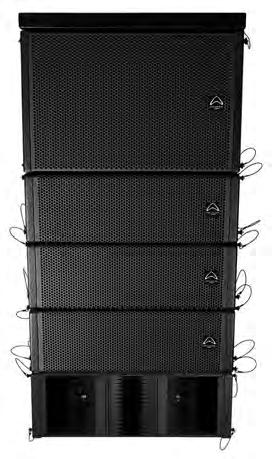
EVO-Fold waveguide and custom phase plugs to deliver a consistent offaxis frequency response. Combined, these features reportedly lead to a reduction in the usual phase issues suffered by traditional two-way line arrays caused by the physical distance between drive units.
The 18-inch T-SUB-AX18B is the latest addition to the company’s T-SUB family of active subwoofers. It has been designed to work perfectly with active tops such as the Tourus, Titan and Typhon series, delivers 900W continuous and is finished in Wharfedale Pro’s polyurea Tough-Tone paint.
www.wharfedalepro.com
MABE strives to provide integrity and high-quality workmanship in all of its HOW installations

SINCE ITS INCEPTION IN 1999, systems integrator MABE has served the HOW industry across the United States, with founder and owner, Harvey Mabe, envisioning a company that prioritises the church’s needs above all else. While most of MABE’s business takes place east of the Mississippi River, its expertise is not limited to a specific region and the company is focused on maintaining the same quality to its work, regardless of location.
What does a typical project look like for MABE? Steve Griner, director of install sales, explains: “First, a thorough revamping of the AVL system, customised to cater to the unique needs and aspirations of the church as it strives for expansion.” That way, the design will then align with a specific style or genre of worship that best caters to the preferences of the congregation.
“From the beginning, our goal has always been to distinguish ourselves from other AVL companies. Our focus is to deliver exceptional quality services. While we may offer the same equipment as other companies, our service is what sets us apart. We constantly strive to exceed client expectations and go above and beyond their needs,” adds Mabe.

options tailored to suit various budgetary constraints. Our team provides a detailed quote outlining the components of an AVL package that aligns with their envisioned requirements, and if it exceeds their budget, we collaborate closely with them to identify cost-saving measures without compromising on the quality of products, ensuring an enhanced worship experience.”

Despite the challenges presented by the pandemic, MABE’s integration division has maintained its full operational capacity. Admittedly, the company has faced, and is still facing, ongoing complications in the supply chain. Mabe adds: “The task of managing supply chain issues while adhering to client deadlines has proven to be quite a challenge. We strive to effectively communicate with our clients to meet their target dates and adhere to their timelines.”
As far as future AV trends for the worship markets are concerned, Richard Vaughan, director of
engineering, suggests two: “Immersive audio systems – I’d love to design more of those as audio seems to be a second thought after the more visual items like lighting and cameras. And second, streaming and broadcasting. Churches seem keen to be more interactive with online users and build a sense of community.”
Clients often look to MABE for guidance in creating a budget that suits their financial situation. Mabe adds: “It can be challenging to gauge their financial situation accurately but it’s our responsibility to identify the most suitable design-build system
As is the case with low to high budgets, Mabe insists that the company doesn’t discriminate when it comes to venue size and scale either. “Our aim is to prioritise each project,” he says. “We strive to design an exemplary engineered system that fits within their budget and also provide them with an outstanding service.”
Although MABE has relied on social media to reach wider audiences as well as Google advertising, word of mouth is said to be the best form of promotion for the company and makes up for a large portion of its business. “We’ve noticed a significant shift in the house of worship market towards streaming during and since the pandemic,” explains Mabe.
“Numerous churches have transitioned to streaming and broadcast setups for online worship services. The recommendations we’ve received mean that our design and installation services have helped churches achieve a top-tier, broadcast-quality setup.”
What’s on the cards for the company in 2024? “We are committed to growing our success and setting ourselves apart, ensuring that we stand out in the industry,” says Mabe. “As our business continues to expand, we recognise the need to add more personnel who have the required skills and personalities to consistently achieve excellent results.”
www.mabepro.com




